We’ve been home in Bristol for the last seven weeks and have been catching up with family and friends. We have a new grandson, Charlie, my son Alex and his partner Sarah’s baby, born on June 17th. We’ve loved spending time with our other grandchildren Isla, Rohan, Bertie and Henry and with the rest of the family. All too soon, in only four days time now, we’ll be returning to Vega in the Seychelles.
In the meantime here is an update on the blog… our time in Chagos.
Sunday 1st to Wednesday 11th May 2022
Our next destination after leaving the Maldives was the Chagos Archipelago, also currently known as the British Indian Ocean Territory (BIOT), which has a particularly shameful history.
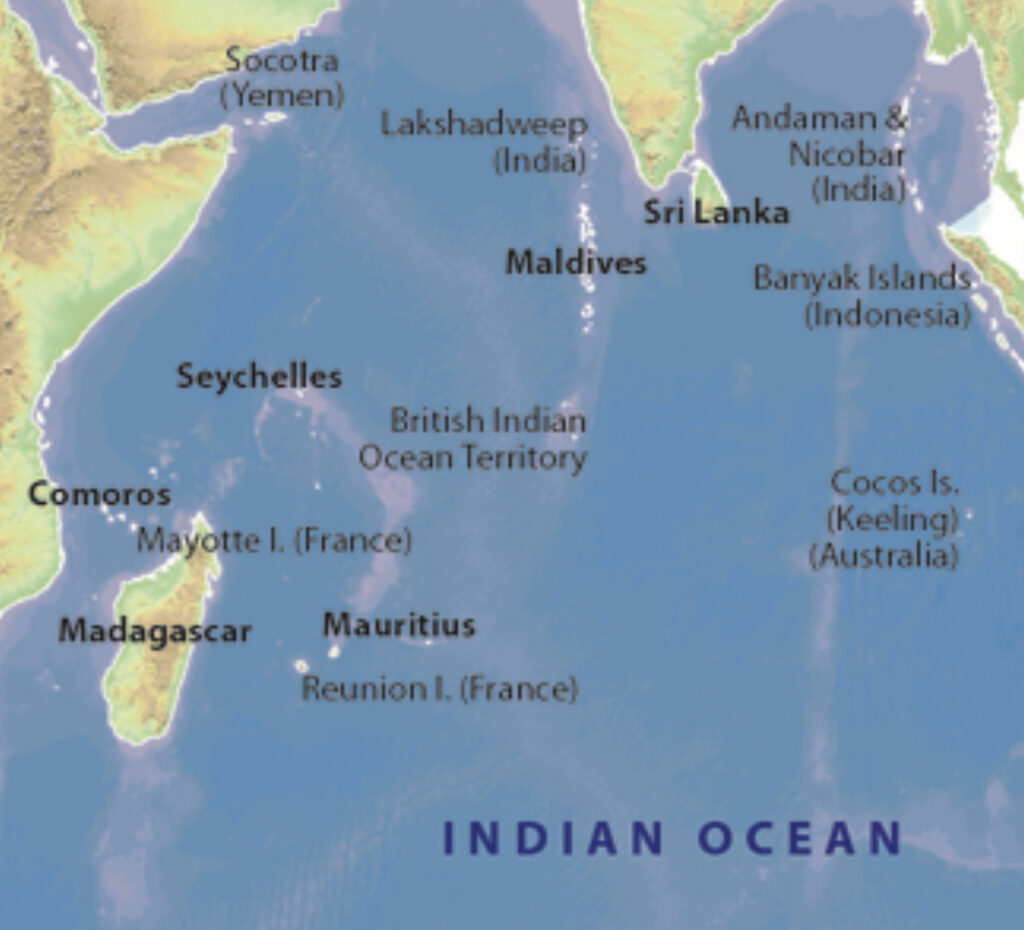
Chagos/BIOT is a group of seven atolls, south of the equator, midway between Africa and Asia, some 300 miles due south of the Maldives and spreading over an area of about 200 by 100 miles.
They were uninhabited until the French established coconut plantations in the late 18th century, initially using slave labour from Senegal, Madagascar and Mozambique. In 1814 Chagos was ceded to Britain by France, along with Mauritius and the Seychelles, in the Treaty of Paris following the defeat of Napoleon Bonapart. In 1965 Mauritius gained its independence but the Chagos Archipelago, which had been considered part of Mauritius, was retained by Britain and the British Indian Ocean Territories was formed. In the 1960s the U.K. and USA had identified Diego Garcia, the largest of the islands, as an ideal place for a military base in the Indian Ocean and in 1966 concluded an agreement to establish a joint military base here, Britain leasing BIOT to the USA for 50 years, with an option of a further 20 years, the agreement now due to end in 2036. In exchange Britain was given a discount of £5million against the price of a US-manufactured Polaris submarine.
Part of the agreement between Britain and the USA was that all the islands of the Chagos Archipelago should be uninhabited and so a law was passed in London making it illegal to be on the islands without a permit. The British had already bought all the Chagos plantations, planning to deprive the Chagossians of income and so encourage them to leave the islands voluntarily. Chagossians who had gone to Mauritius to visit family or on the annual shopping trip, found there was no longer a ship that would take them home. In 1971 the remaining population of around 1000 people, who were descended from the slaves and indentured workers, were forcibly removed to Mauritius or the Seychelles. As part of the ‘sanitising’ of the islands it was also ordered that all the dogs on Diego Garcia were killed and more than 1000 pets were taken away and gassed. The Mauritian government was given £3 million to take these ‘refugees’ who were then dumped in Port Louis without housing or work and left in abject poverty. They were each eventually (after several years) paid off with a paltry sum of money to renounce their rights to ever return to the islands. Some moved to the U.K. and became British citizens.
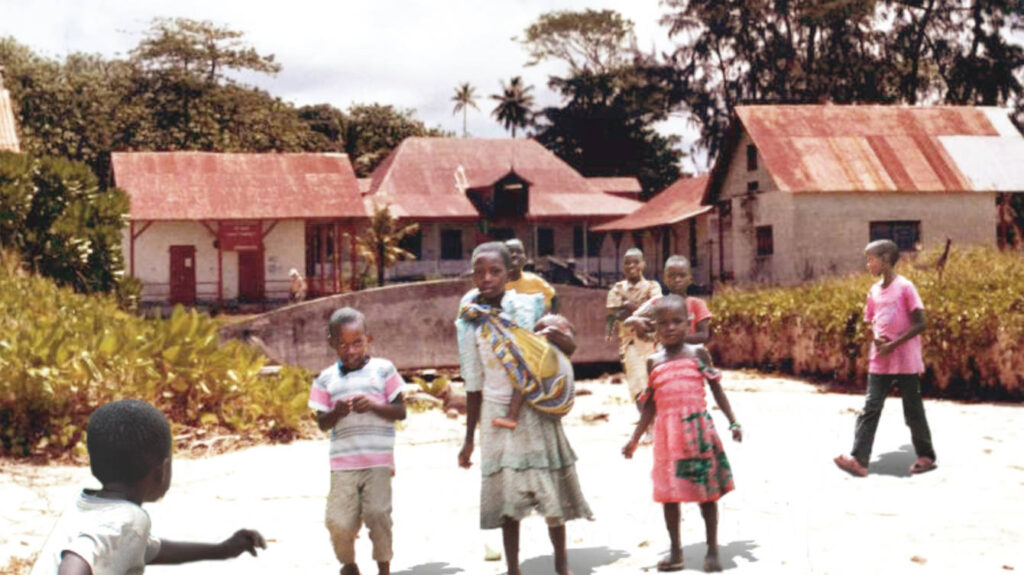
Chagos has attained mythical status in yachting circles for its beauty, isolation and the sheer difficulty in visiting. The islands are now uninhabited apart from Diego Garcia, and are an oasis for marine and island species. It is not a tourist destination, there are no commercial flights, charter trips or cruises. It is impossible to visit BIOT unless you are part of the military or you have a private yacht and a permit and you need to be completely self-sufficient in fuel, food and water.
Hugh had successfully applied for one of the few, much coveted permits granted each year to visit Chagos, and we had permission to stay for four weeks in May, the permit costing £100 a week. Last year only a handful of permits were given to yachts and currently only three vessels are allowed at any one time. Even then it is only permitted to visit two small atolls in the north of the archipelago, Peros Banhos and the Salomon Atoll; the airbase on Diego Garcia is strictly off-limits. The only valid reason you can give on your application is ‘to gain safe passage across the Indian Ocean’. You must have insurance to cover medical evacuation and wreck removal, and scuba diving and spear-fishing are strictly forbidden.
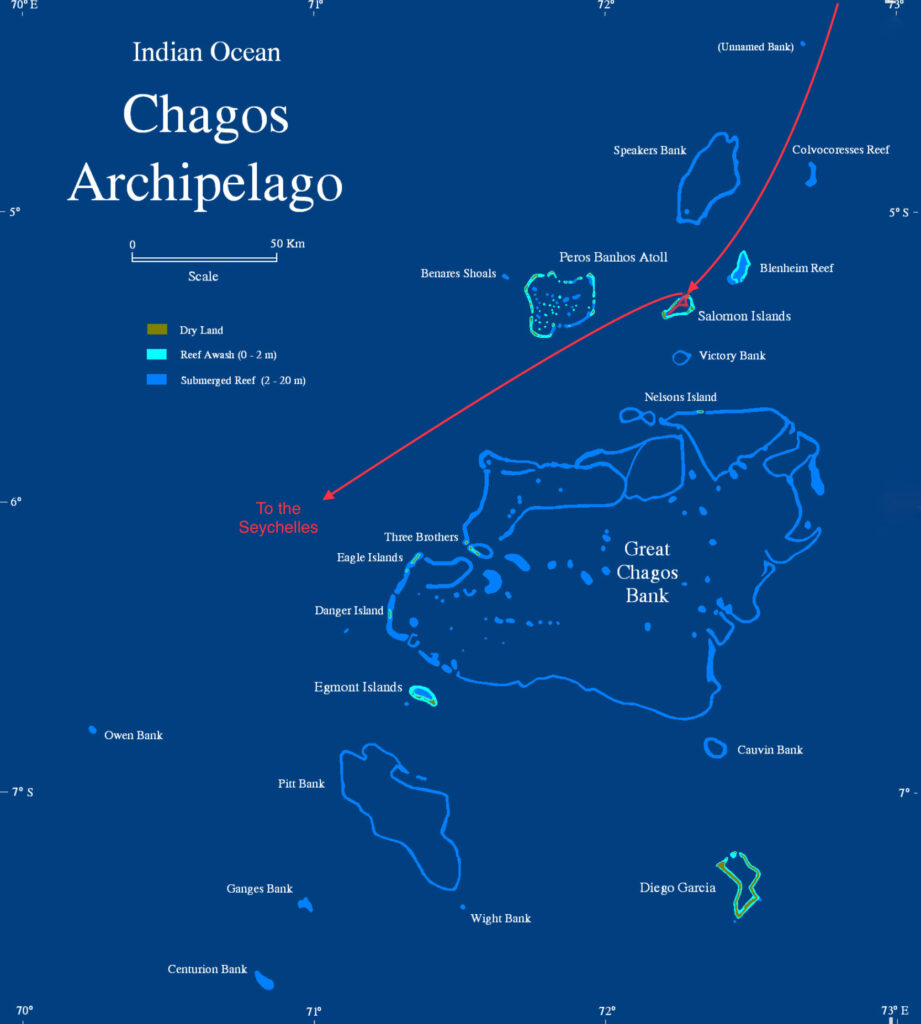
Several years ago there was a group of yachts that spent months at anchor within the two atolls, forming a community of ‘sea gypsies’ as the BIOT authorities referred to them. They were tolerated for years and paid $80 for a three month permit. When we first arrived in the Maldives we met Erja and Glenn who had been cruising the world for 30 years but were now on their way back to Europe. They had in the past spent several seasons in Chagos, six months at a time, and Erja told me about the self-supporting community of yachties who anchored inside the reef at the Salomon islands. They kept the paths and the ruined settlement there cleared and planted lemon and papaya trees in readiness for the eventual return of the Chagossians. She let me copy her hand drawn map of the village on Boddam island, which showed the location of various buildings, the hospital, church, bakery, etc etc.
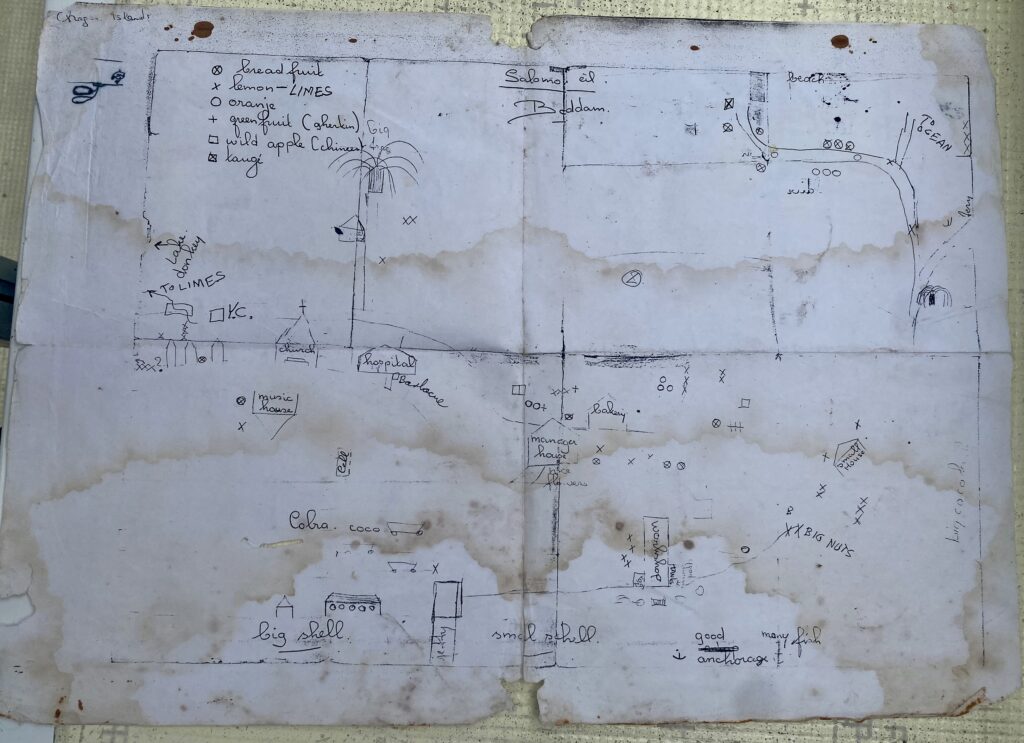
In 2010, to prevent the return of the Chagossians and limit access by yachties, so effectively getting rid of the ‘sea gypsies’, the U.K. established a marine reserve, the Chagos Marine Protected Area. Since then the number of permits issued each year to yachties has been strictly limited.
It is 280nm along the rhumb line from Gan, the most southerly island of the Maldives, to Salomon Atoll in the Chagos Archipelago and we decided to leave two days before very strong winds were forecast to hit the Southern Maldives. We anticipated a three day passage and were up by 5.30am on the morning of our departure. After a cup of tea we finished clearing up and got the dinghy out of the water and stowed on deck. Hugh raised the anchor and I aimed to follow our track in on the plotter in order to safely get back out through the narrow gap in the reef. Only when I noticed that I was about to drive Vega onto the reef and did a sharp right turn to avoid it, did I realise the plotter wasn’t working properly. Too much reliance on electronic equipment and not enough on my own eyes!
As we headed south after leaving the atoll a school of spinner dolphins approached, leaping and spinning, then playing around the bow. There must have been over 50 of them. A great goodbye from the Maldives.
The three day passage started well as the winds gradually increased from 8-9 knots to a comfortable 14-18 knots which had us romping along at 6 knots, although with the wind from the SW we were heading rather more east than we’d hoped. As we sailed south we were in the ICTZ (the intercontinental transitional zone) otherwise known as the doldrums. A bit of a misnomer as it’s less Ancient Mariner as it is in the Atlantic Ocean, more of a Perfect Storm in the Indian Ocean, with winds sometimes up to gale force in April and May, with frequent squalls. Over the following days we experienced some nasty squalls with heavy rain, the wind gusting over 30 knots and howling through the rigging, when we had to reduce the sails to a fully reefed mainsail and a tiny scrap of foresail. Thankfully the squalls didn’t usually last much more than an hour or two. At other times the wind died and we had to motor. Sometimes we even had perfect winds of 10-15 knots and could enjoy pleasant and gentle sailing.
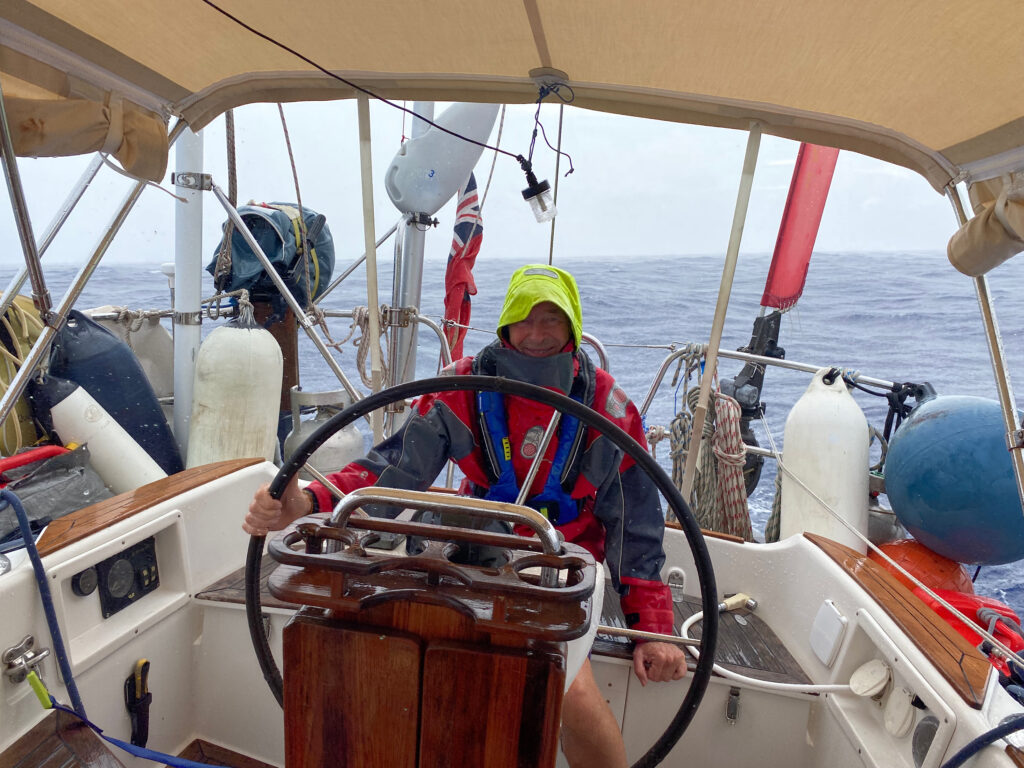
On the last day of our passage we had heard a strange ‘boing’ sound every 5 or 10 minutes accompanied by vibrations throughout the cockpit. Hugh checked the engine, put the GoPro over the side to look at the propeller and we looked through the lockers, but were completely unable to identify the source of this noise.
At last we spotted land..… three small islands on the horizon, low-lying and, as we neared them, the technicolour green of palm trees. I felt so elated and whooped with excitement and the anticipation of a new place to explore and just us (I hoped)! It looked so beautiful.
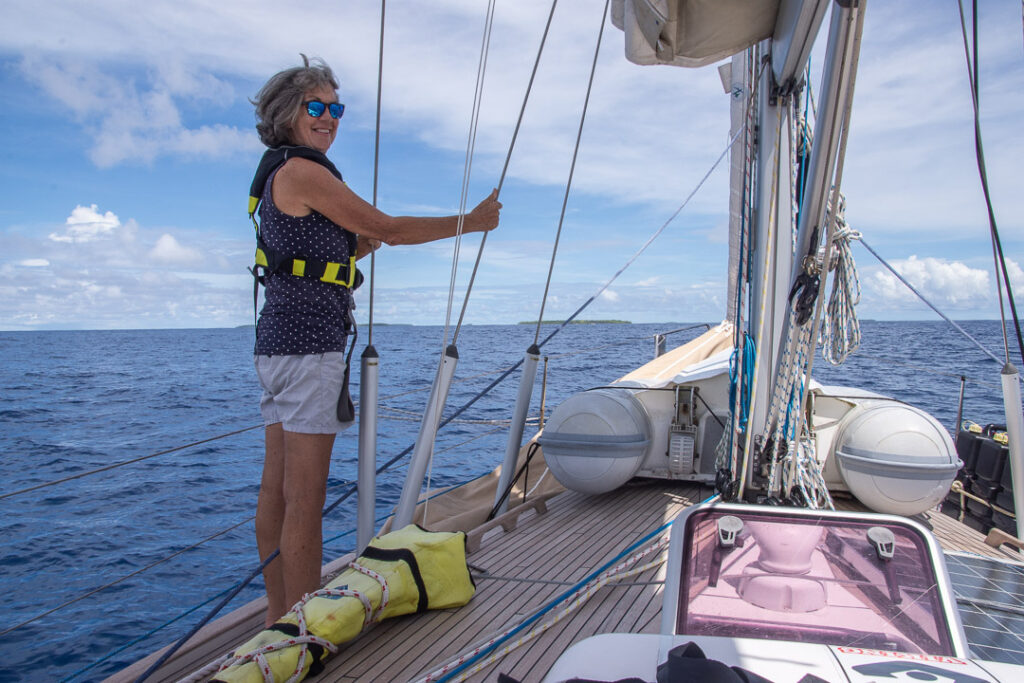
We entered through the pass in the north of Salomon Atoll and motored across to where we could drop anchor between Ile Fouquet and Ile Takamaka in a shallow sandy area.
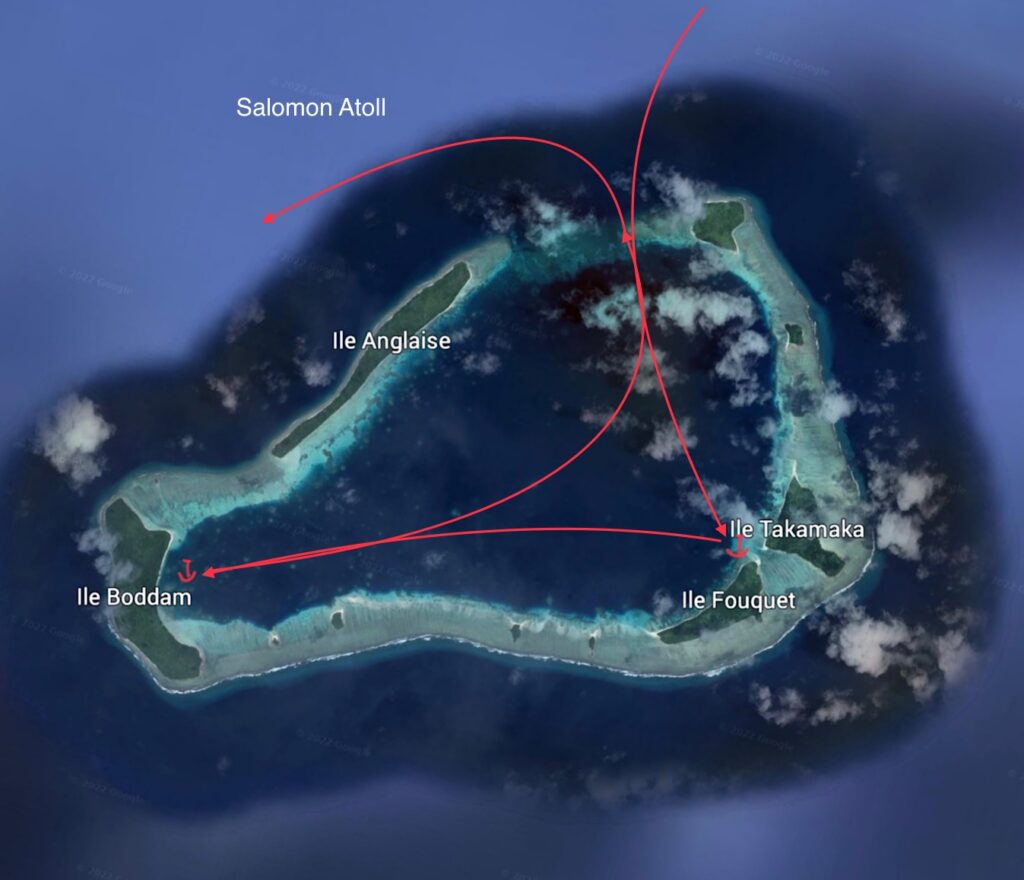
I went for a swim but stayed close to the boat. I’d heard from other yachties that there were lots of sharks around, mostly harmless reef sharks but also tiger sharks, one of the most dangerous shark species, although during our time here we only ever saw one small reef shark.
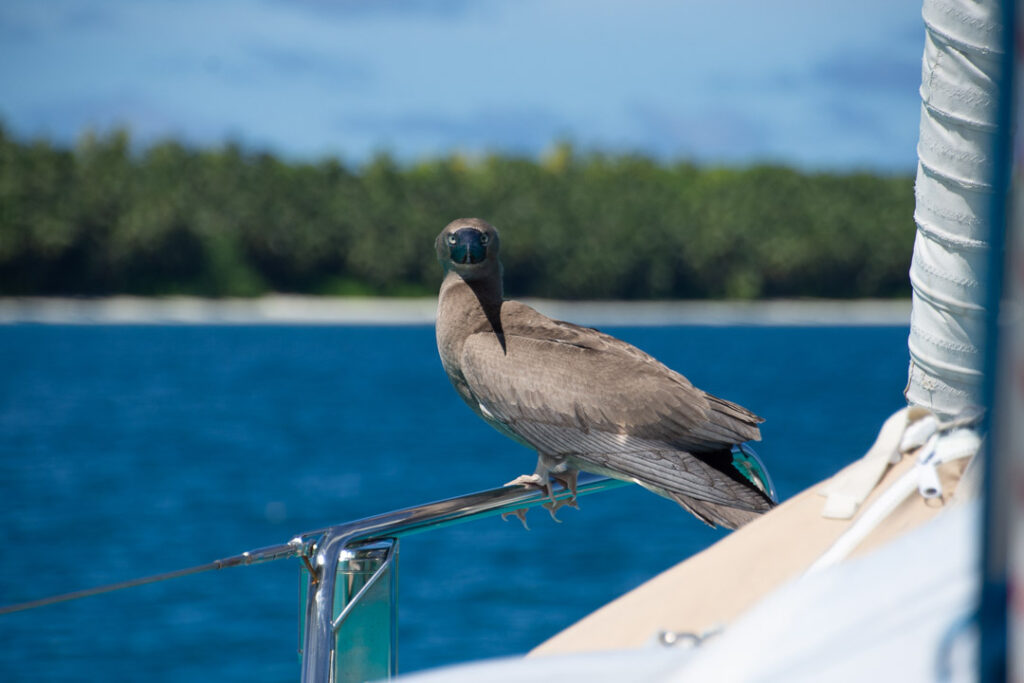
On our first evening at anchor in Chagos we took our cans of lager on deck to watch the sunset but instead watched as a heavy black cloud approached and by the time we’d cleared the cockpit and secured the windows and hatches, the wind was howling and the rain pouring down. During our remaining time in Chagos we had glorious weather, blue skies and cooling sea breezes. The sunsets were fabulous as we sat in the cockpit and watched the sky turn orange, reflected off the sea.
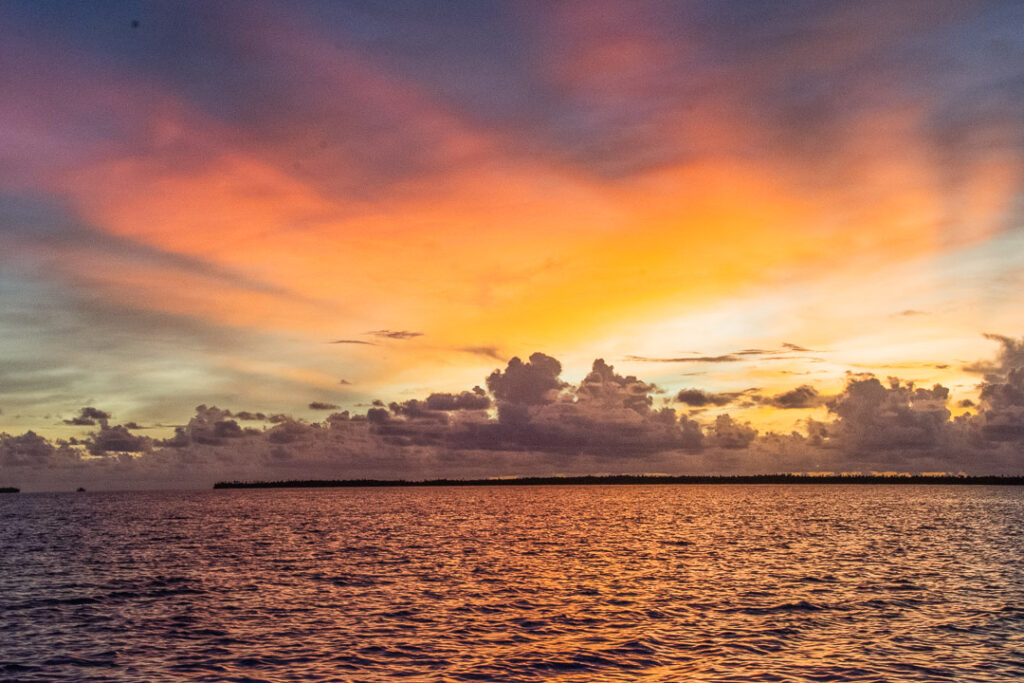
Squid liked to drift at the back of Vega, getting some shade from the sun, a large ray swam slowly under the boat, sometimes dolphins leapt in the distance. Occasionally the head of a turtle appeared as it came up to breath for a minute before diving back down.
Every day we went ashore for walks around the islands. On the beach of Ile Fouquet was the wreck of a large catamaran, the Black Rose, which was grounded in 2012 when her anchor dragged during a storm. She had been brand new and on her way to be delivered to her new owner in Vanuatu. There isn’t much to see of her now as she is largely buried in the sand.
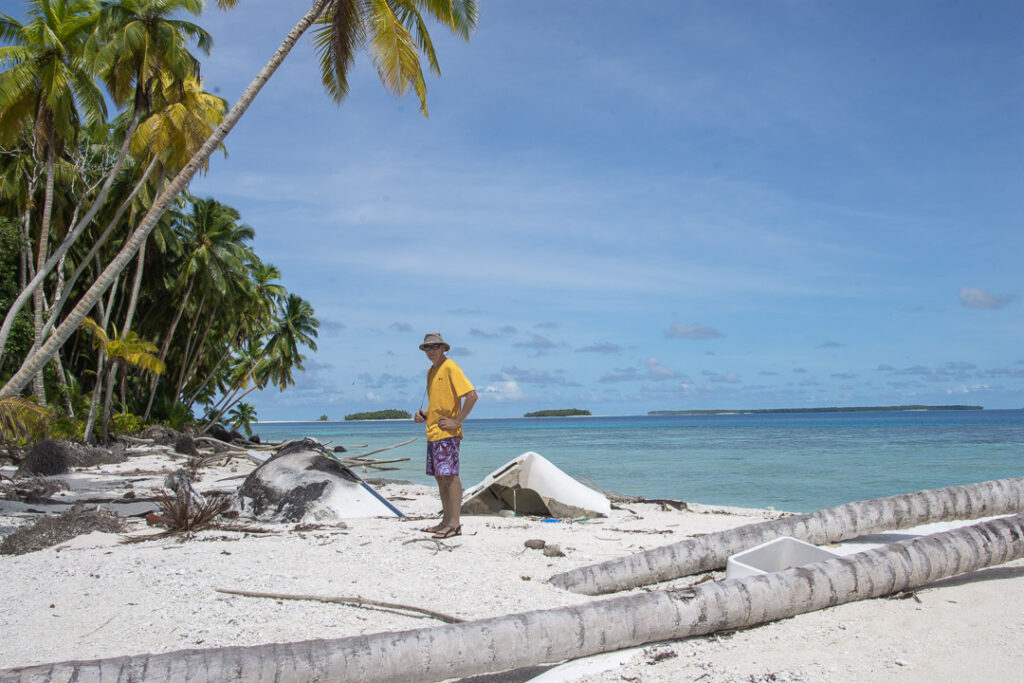
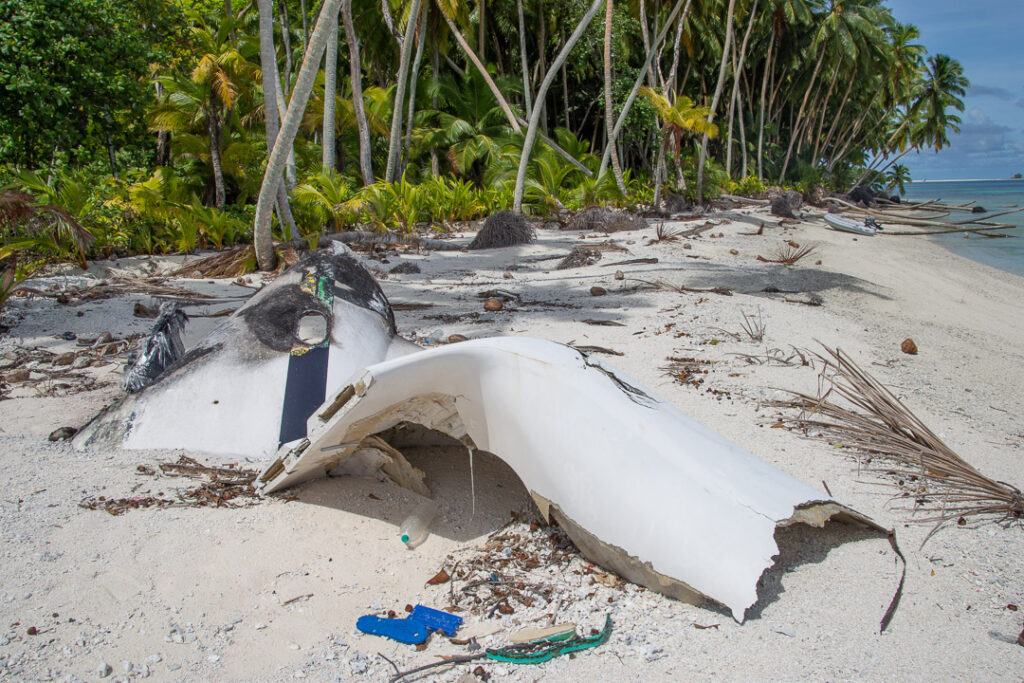
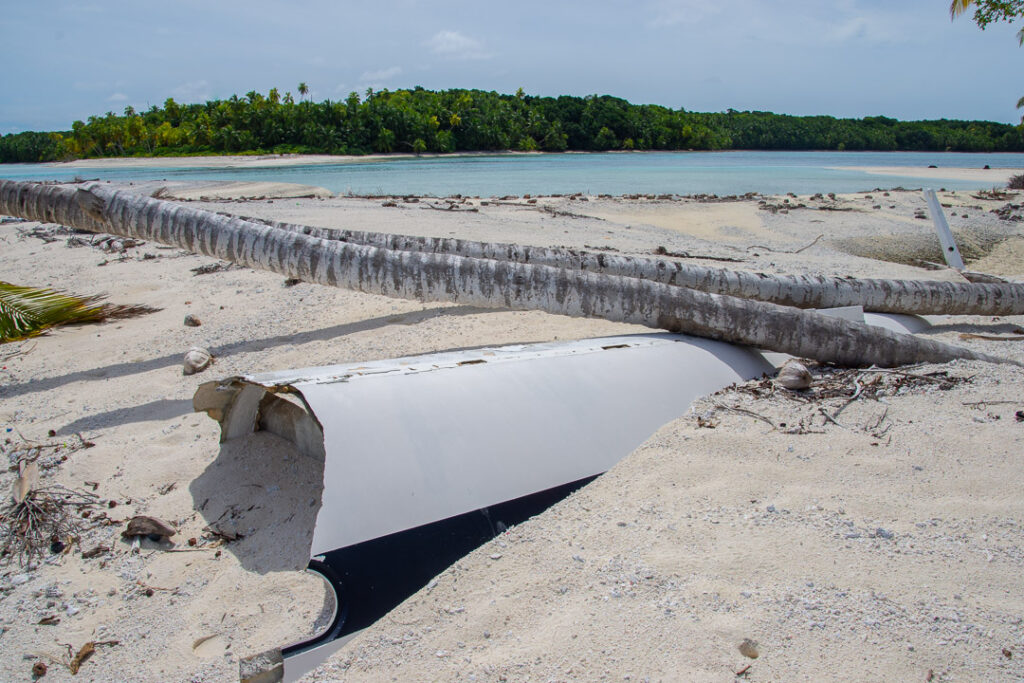
We walked around Iles Fouquet and Takamaka, the vegetation too dense to venture far inland. The interior of the island is mostly plantation, after the original vegetation was cleared and given over to the cultivation of coconuts.
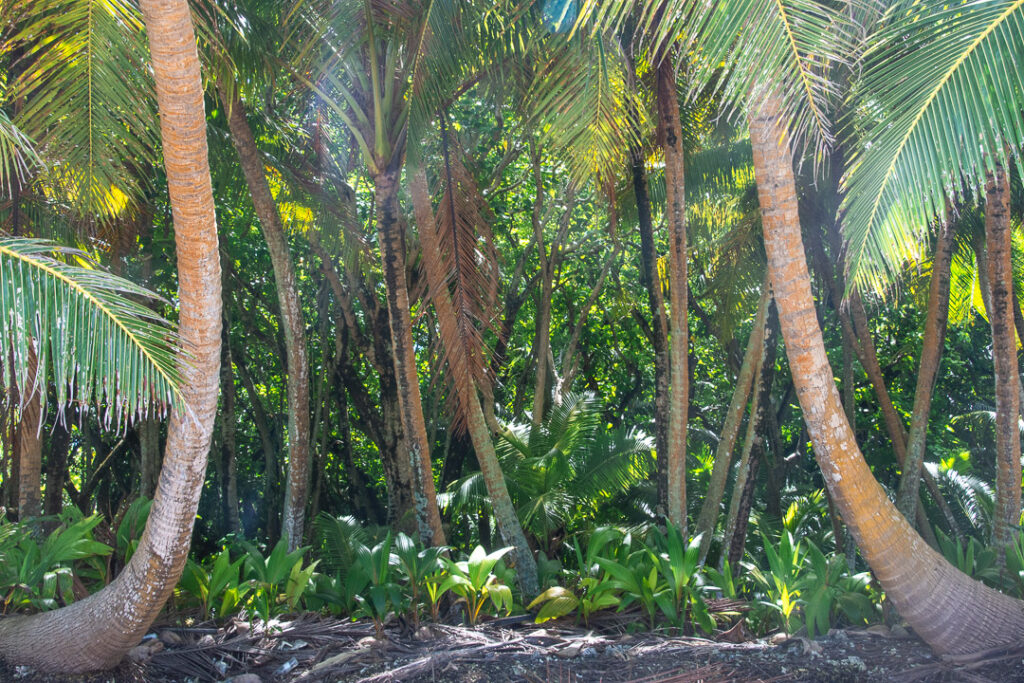
Along the rugged shore between the two islands rock pools were left at low tide and numerous red crabs and sandy coloured ghost crabs, their eyes on stalks, scuttled off to hide in the rocks.
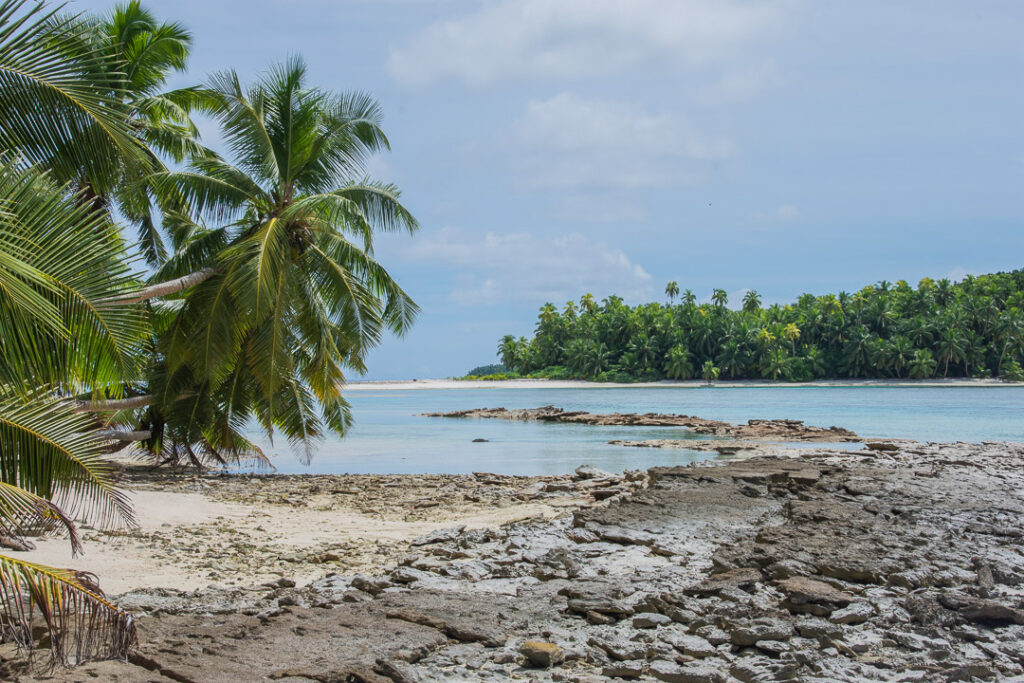
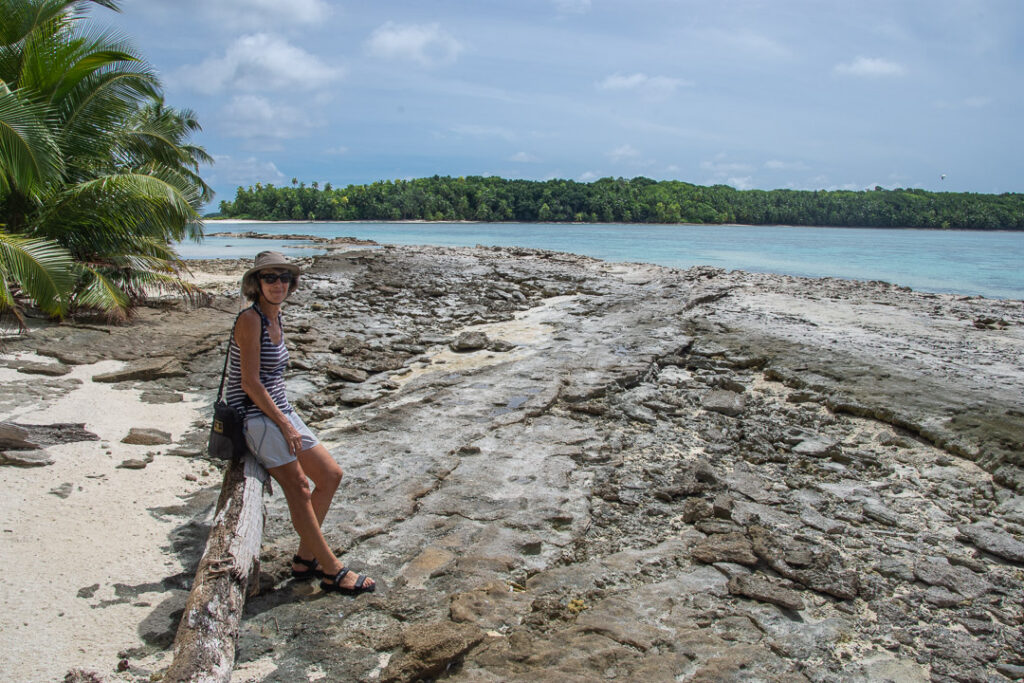
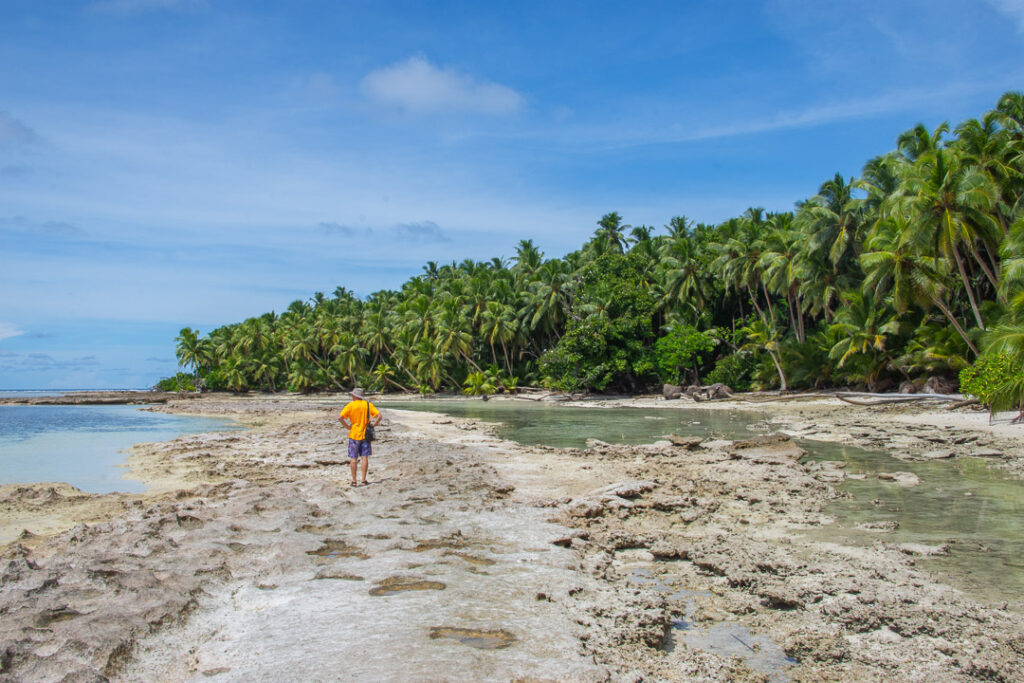
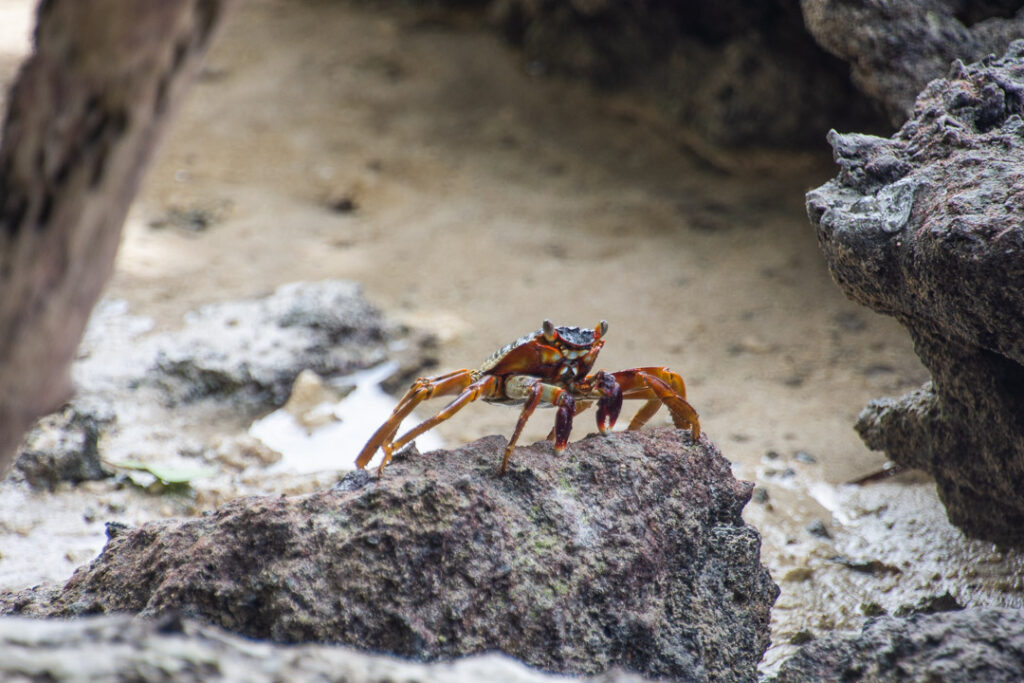
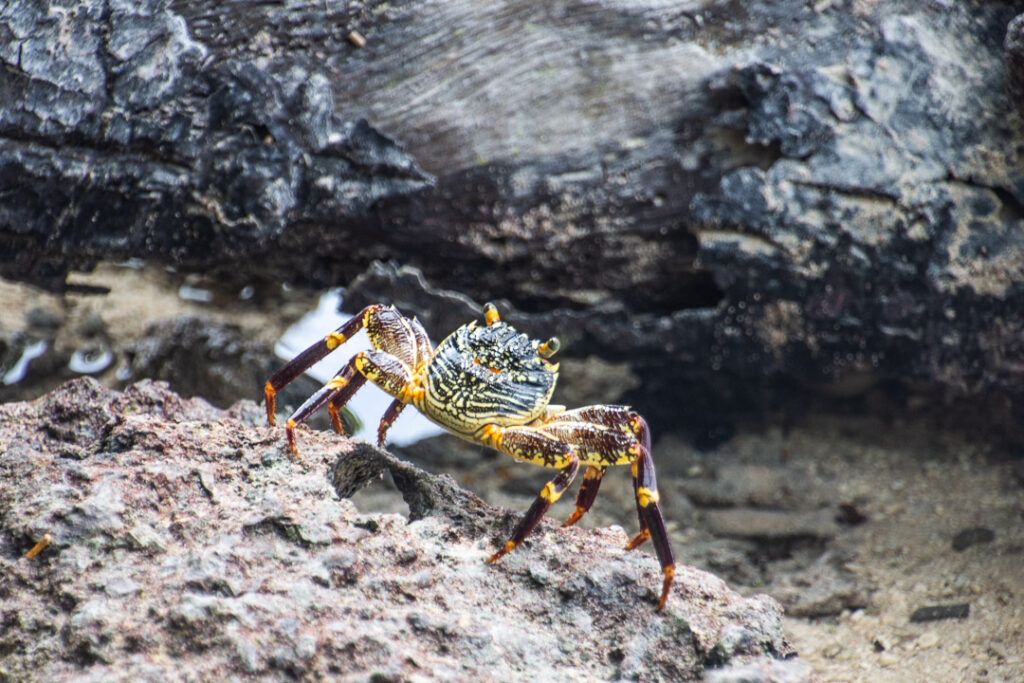
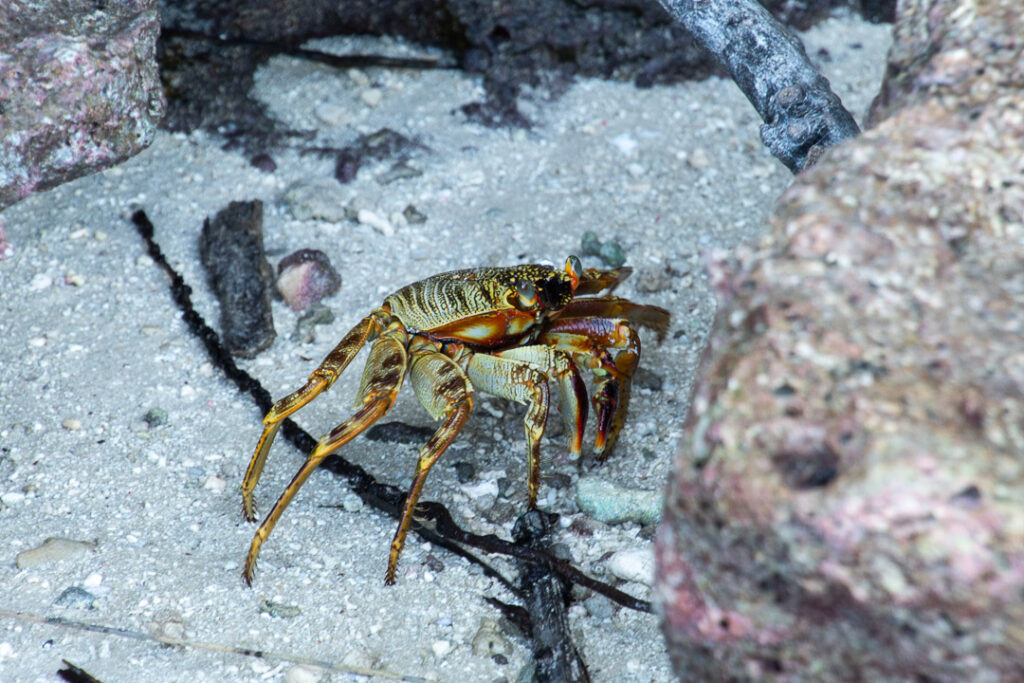
Most of the shells on the beach were occupied by hermit crabs which would withdraw into their shells if we came too near.
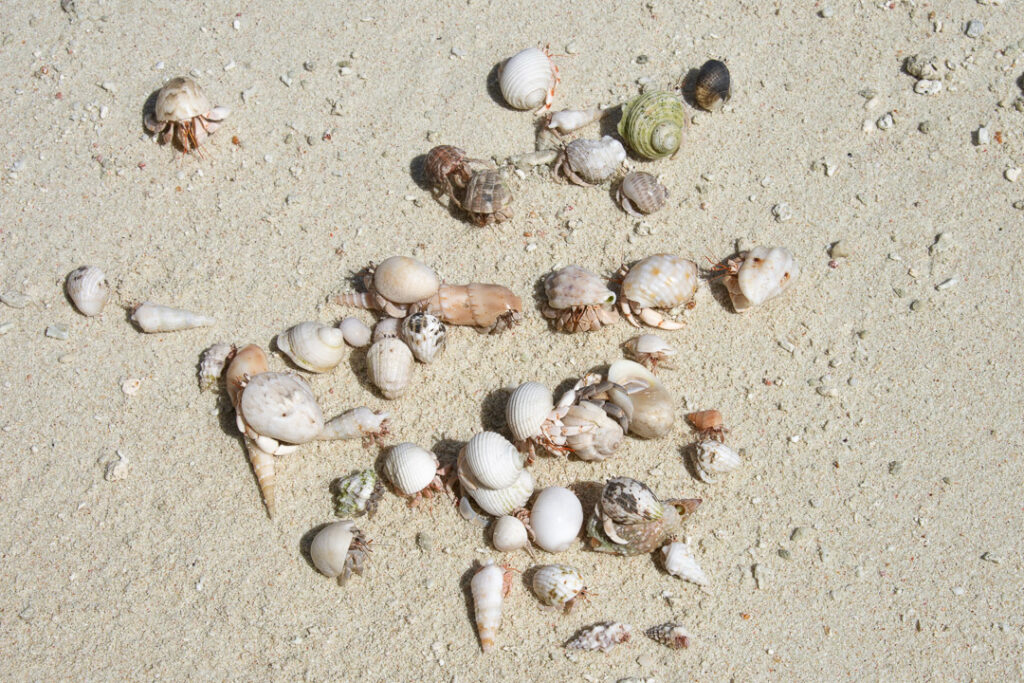
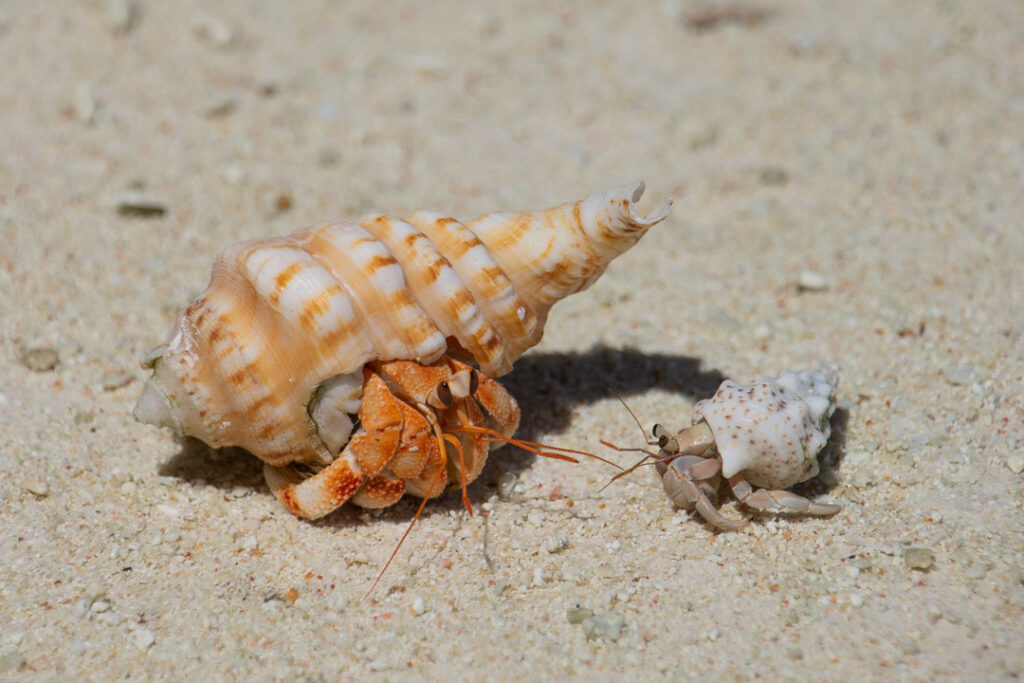
A black ray moved through the shallow water in a channel along the coral shelf, occasionally kicking up sand. A small cream-coloured eel in one of the rock pools wrapped itself around a rock to try to camouflage itself and when I lifted the rock it wriggled its way off at great speed.
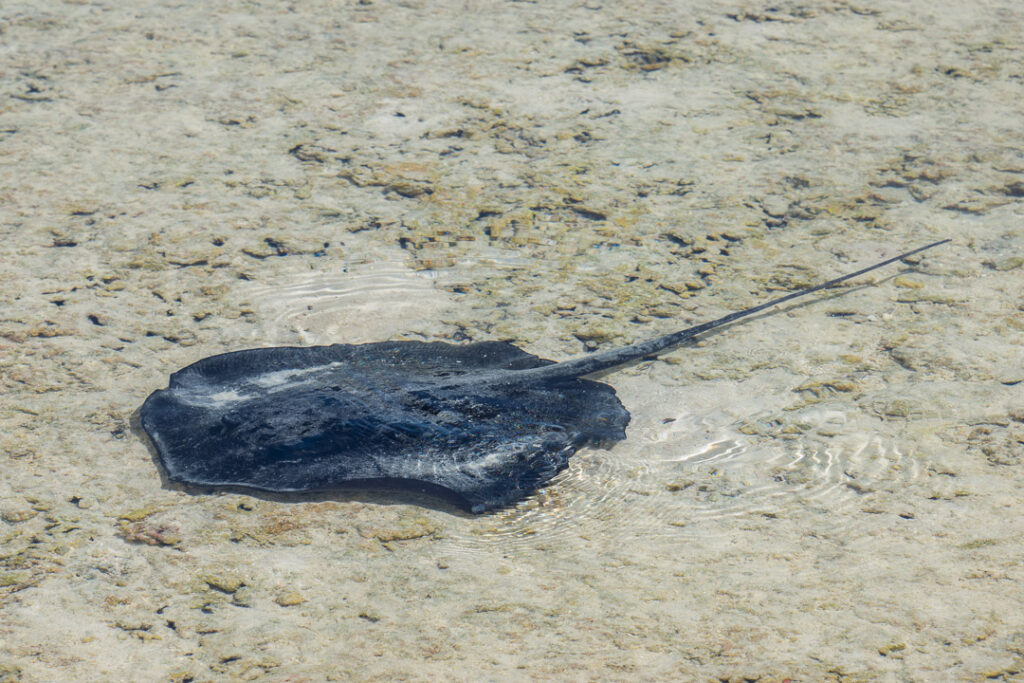
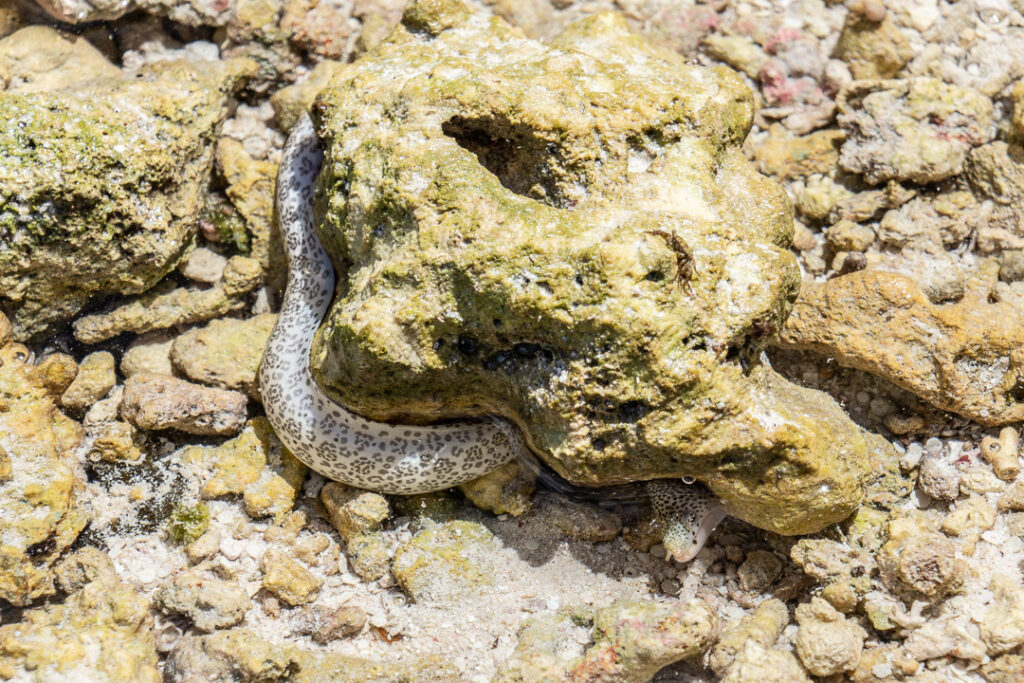
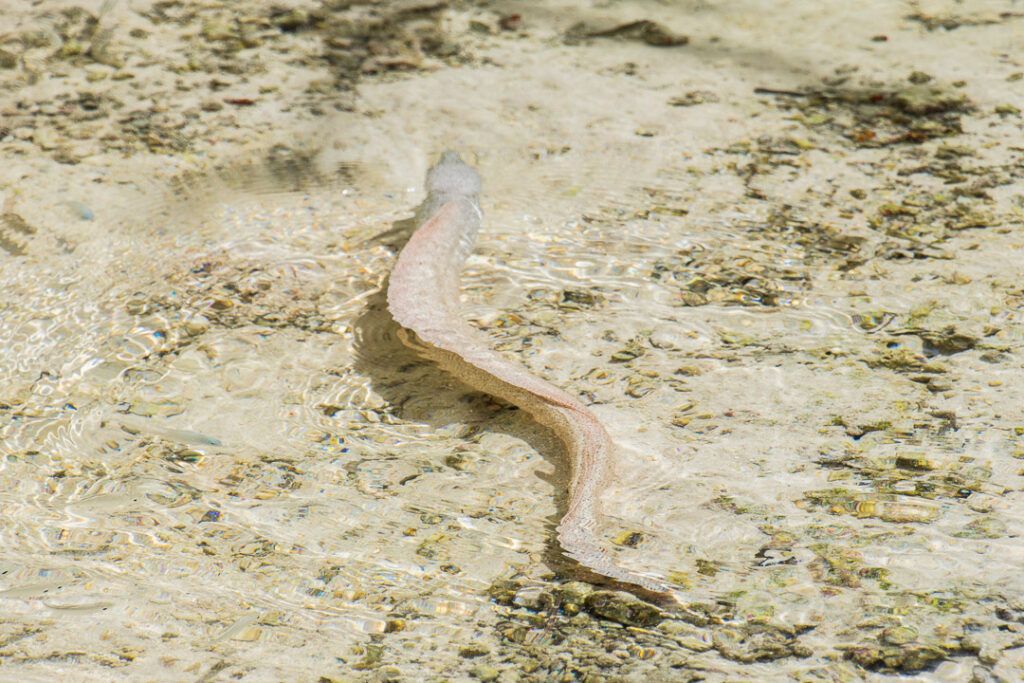
In the native hardwood trees comical red-footed boobies make their nests, squawking and clacking a warning as we approached. High above in the sky frigate birds soared. Pretty white terns chased each other around over the palm trees. Rats had been inadvertently introduced to the island so birds that nest on the ground no longer breed here.
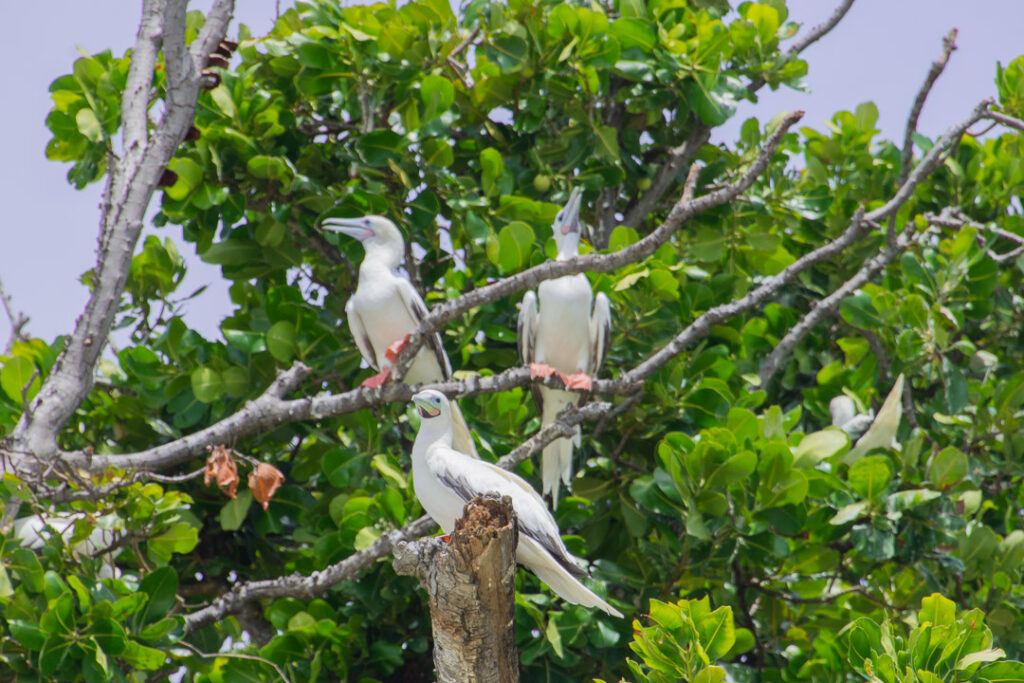
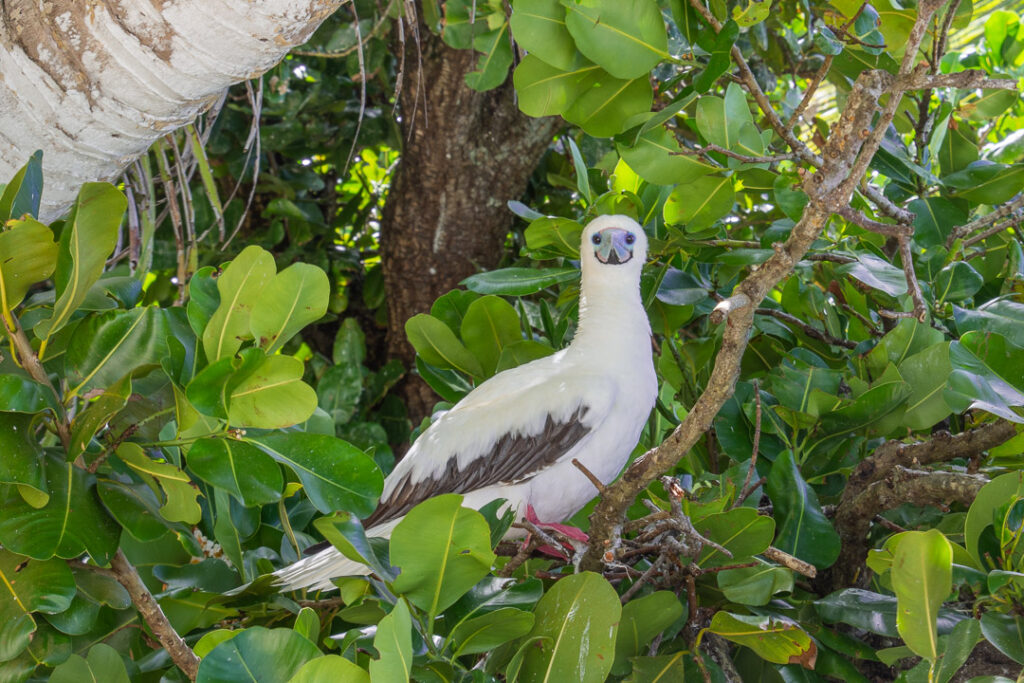
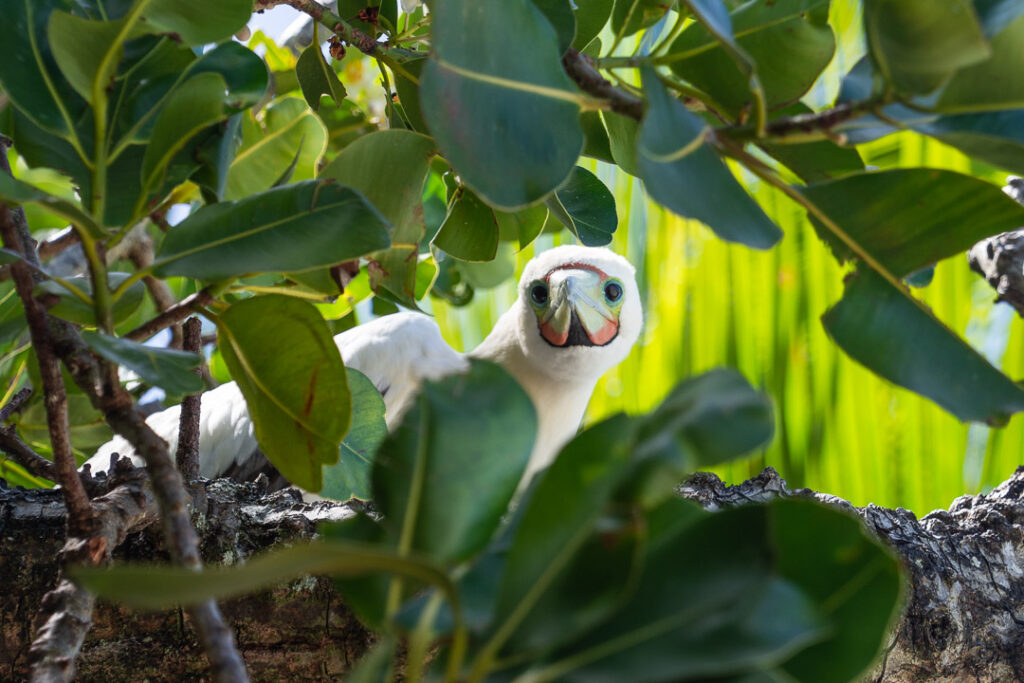
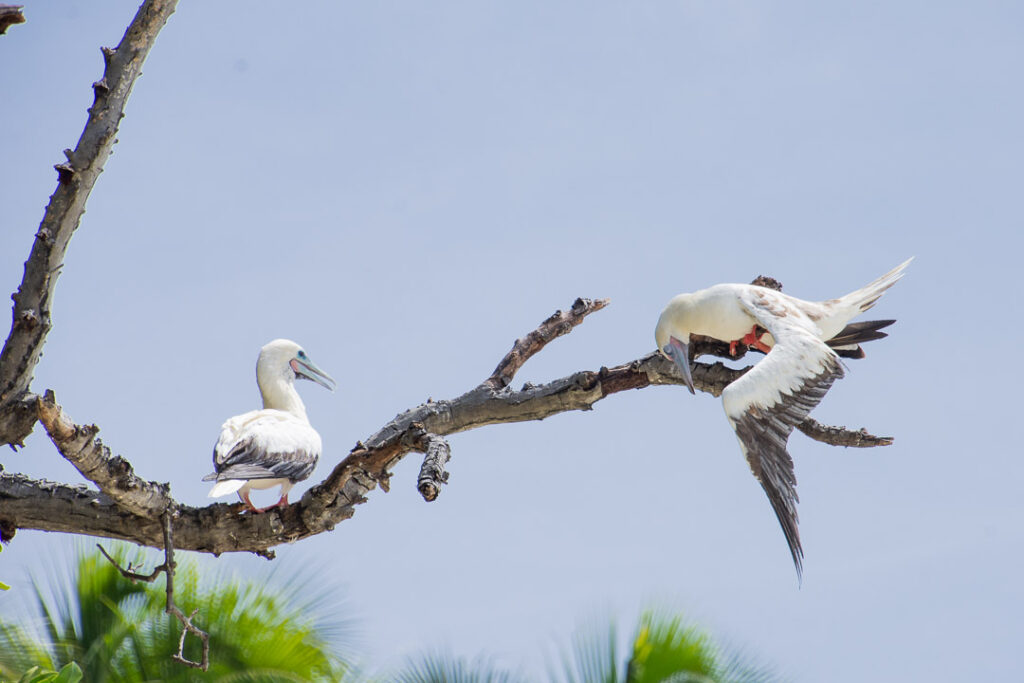
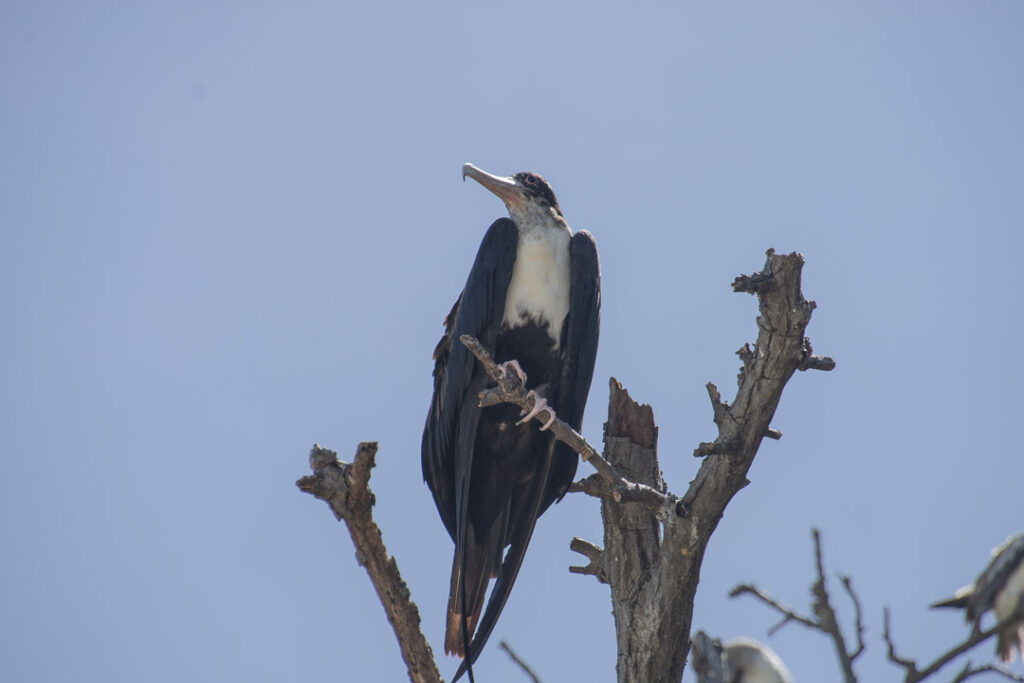
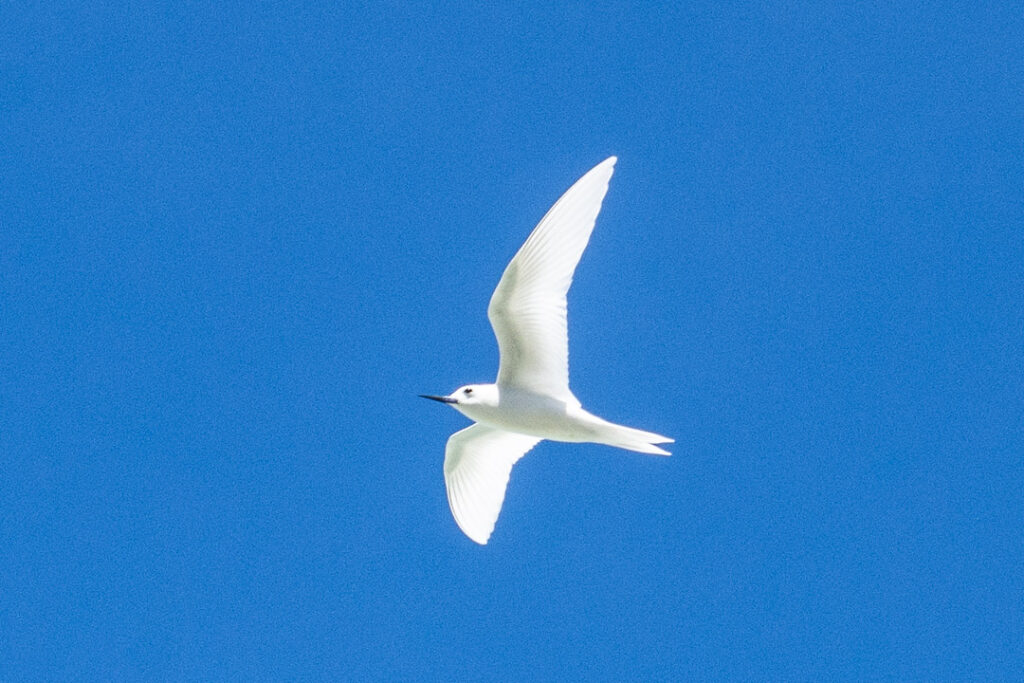
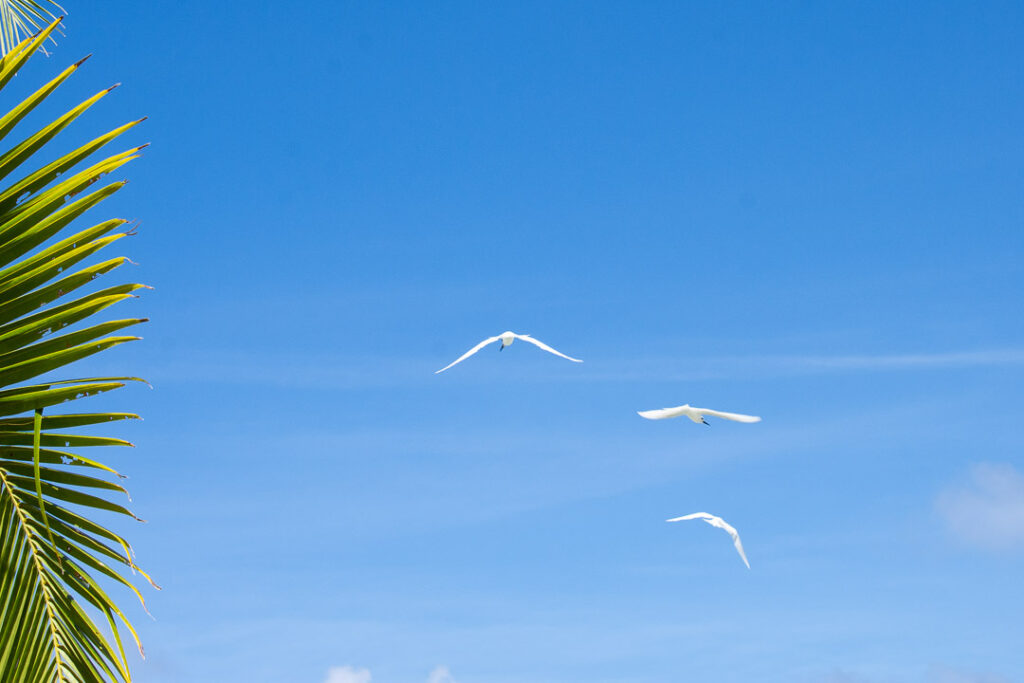
We walked along the length of Ile Fouquet, palm trees overhanging the narrow beach and laden with coconuts ( we hoped they didn’t fall on our heads as we passed underneath), to where a fishing boat was stranded high and dry on the sand bar. It was from Sri Lanka and we were later told that the fishermen on it had been rescued by another fishing boat.
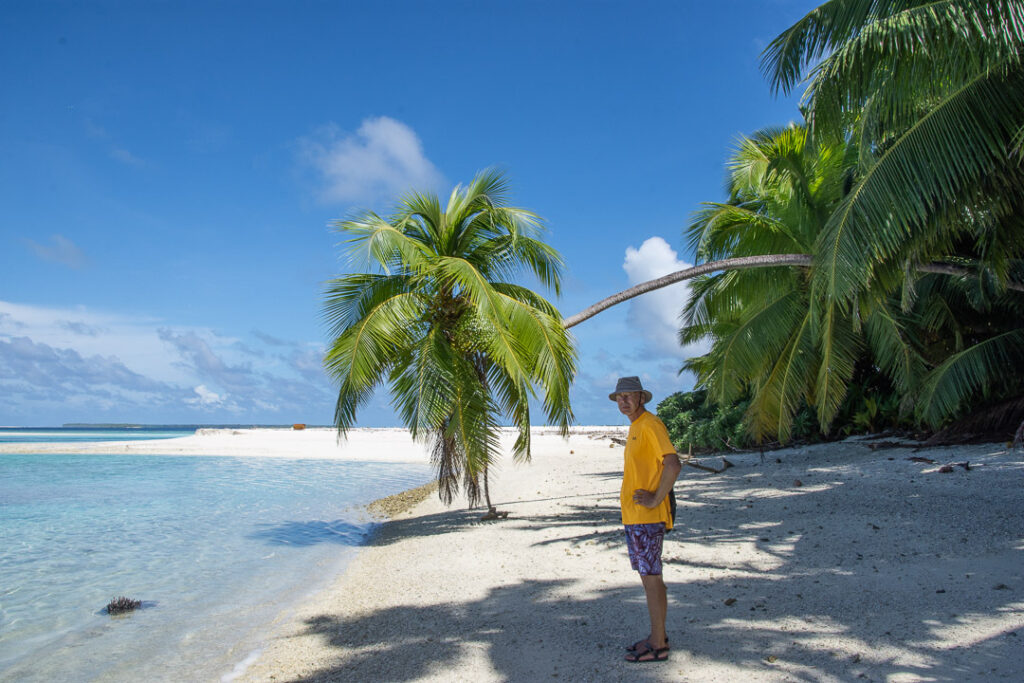
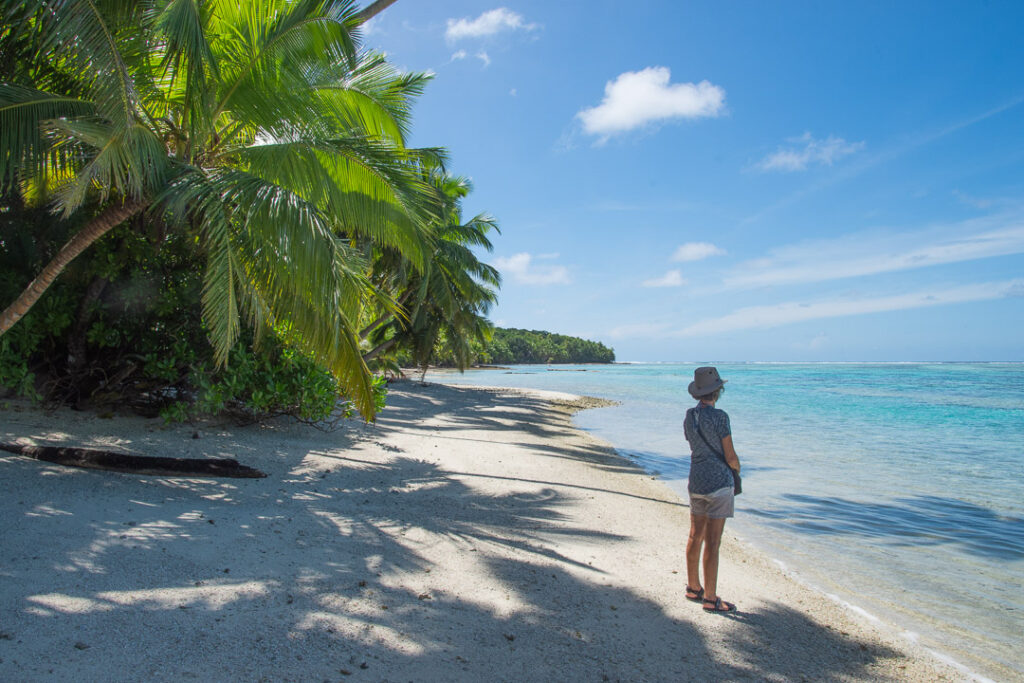
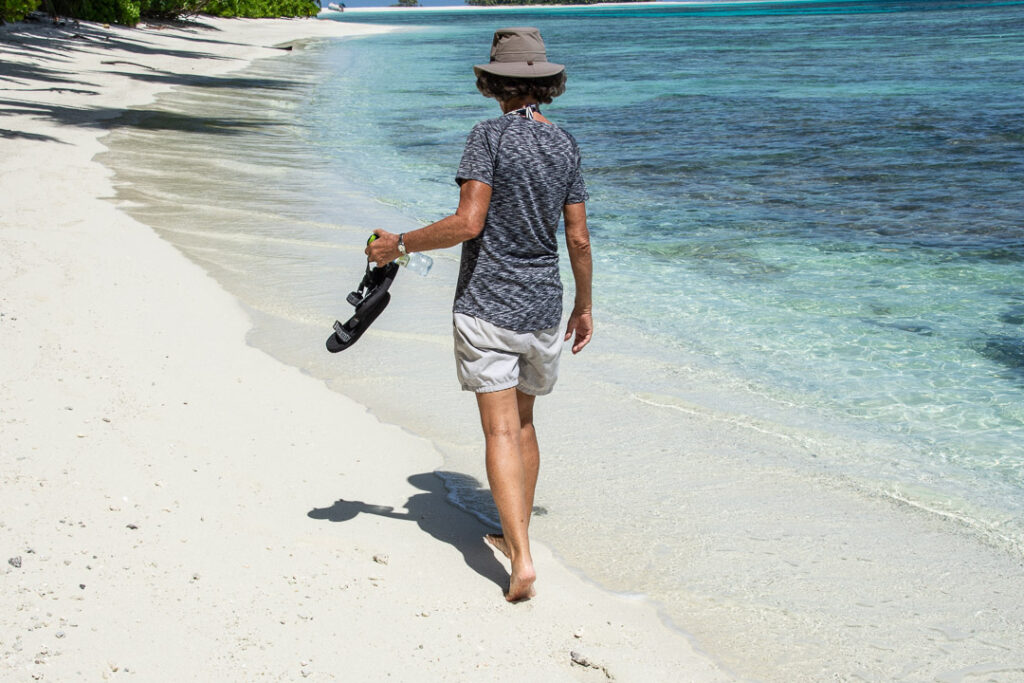
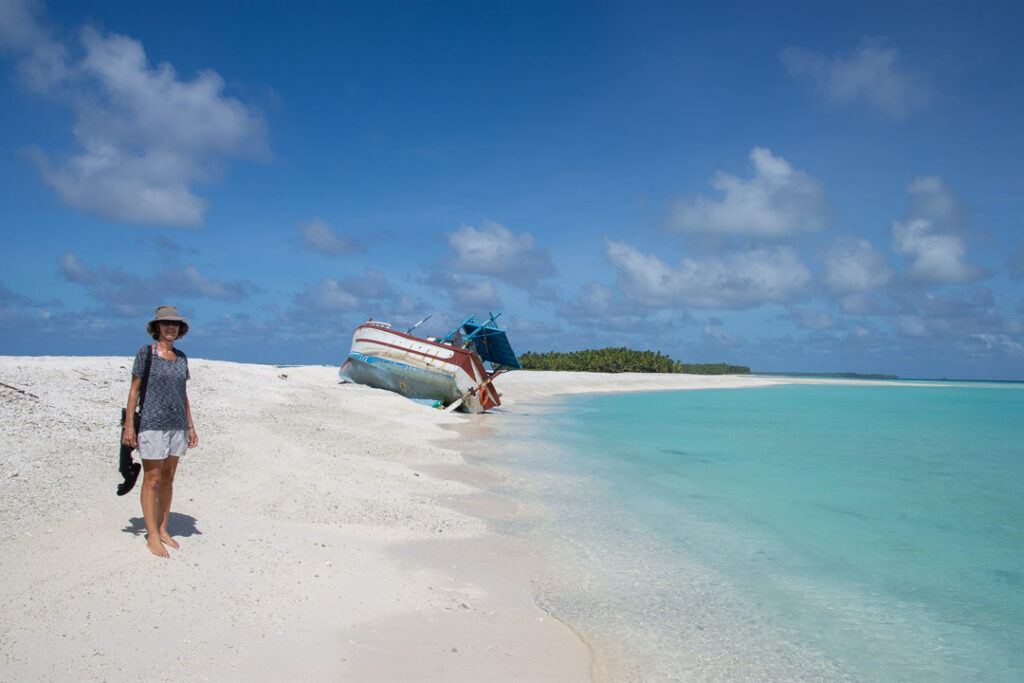
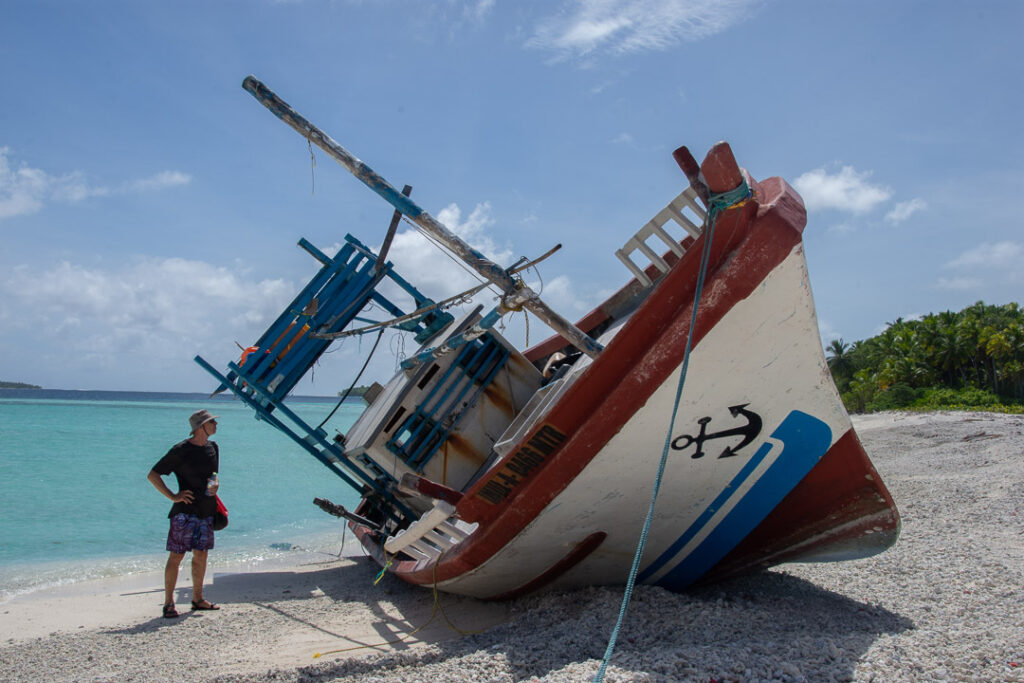
Back on board Vega we did various jobs, ran the water maker to refill our tanks, made bread and cake, washed clothes, blogged and sorted photos. We cleared out the chaos in our rear cabin to gain access to the engine compartment. Hugh wanted to see if he could find the cause of the strange boing sound and vibrations that we’d first noticed just before we arrived here. He found a patch of fine black debris by the drive shaft which suggested a worn bearing. I filmed the propellor underwater using the GoPro and that seemed to be fine. Messages were sent to Craig in Thailand and sailing friends Jon and Ingvar, who are both engineers, asking their opinions on the problem.
Although the largest community of Chagossians had lived on Diego Garcia, which is where the US naval base now is, about 100 had also lived on Ile Boddam which was 4 miles across the lagoon from our anchorage. I was desperate to visit the settlement there, but with our concerns about the drive shaft we were nervous about causing further damage by motoring. We eventually decided to motor slowly over and I sat on the bow watching out for bommies, the shallow coral outcrops which rise up steeply from the seabed (we only just missed one as I had been looking at Google Earth on my phone rather than watching out). After dropping the anchor in 11 meters depth in a gap between the reefs just off Ile Boddam, we had a late lunch then headed over to the island in the dinghy, landing on the narrow beach by the ruined jetty where once coconut was loaded onto boats. A large coconut crab was guarding the overgrown path through to the ruined settlement and seemed completely unfazed by us and reluctant to move until Hugh poked it with a stick. At a foot across with huge claws it would have made a good dinner and is considered a delicacy and an aphrodisiac but in Chagos killing them is prohibited (not that I could have plunged one into boiling water anyway).
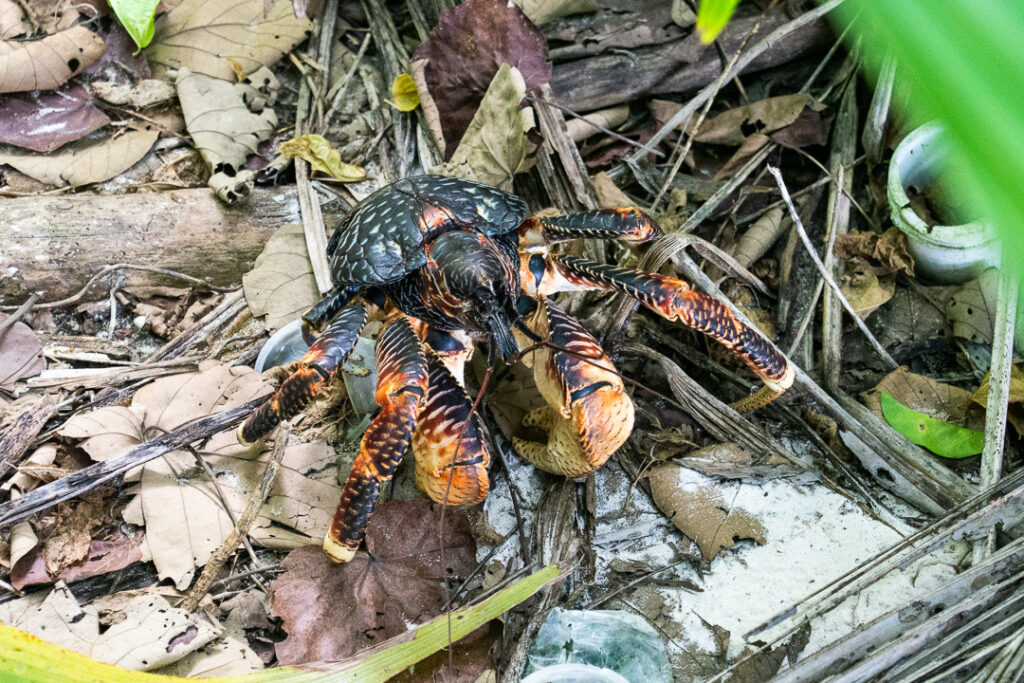
The settlement was overgrown and rather depressing. Next to the beach there was a large white cross and below it two plaques commemorating visits by Chagossians in 2006 and 2022. We wandered around and tried to identify some of the buildings on the map we had but the paths were too densely overgrown to venture much further and the light was fading.
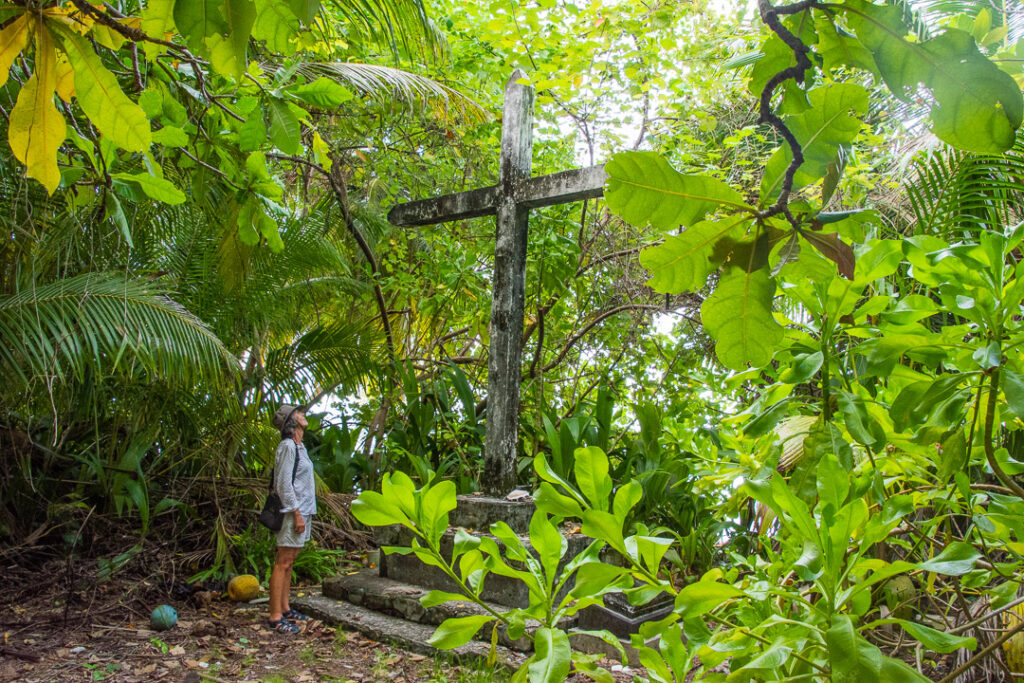
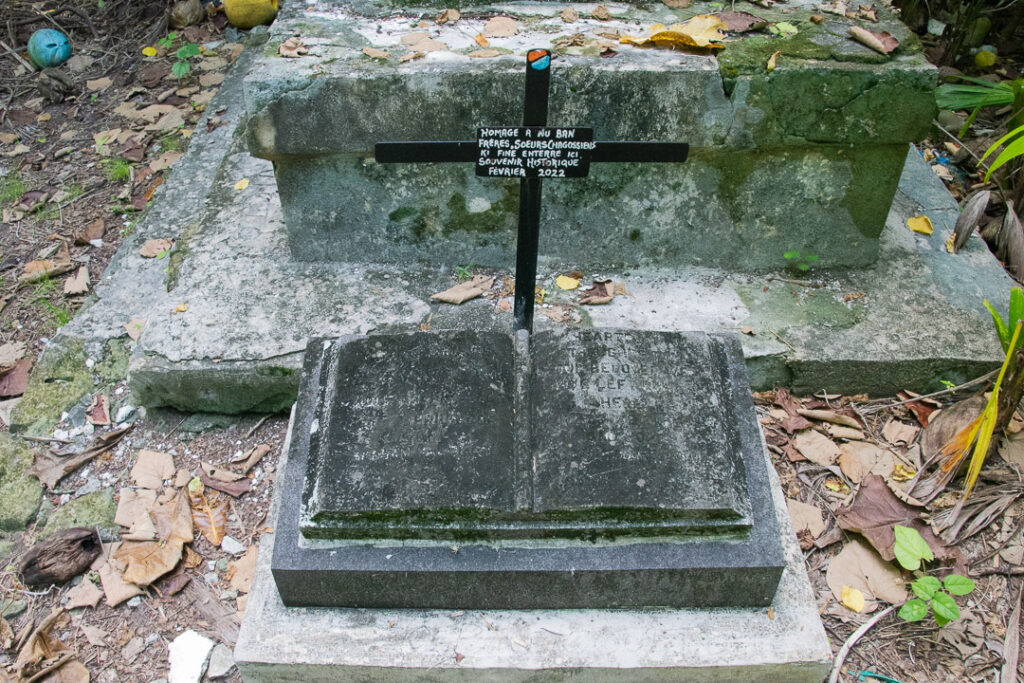
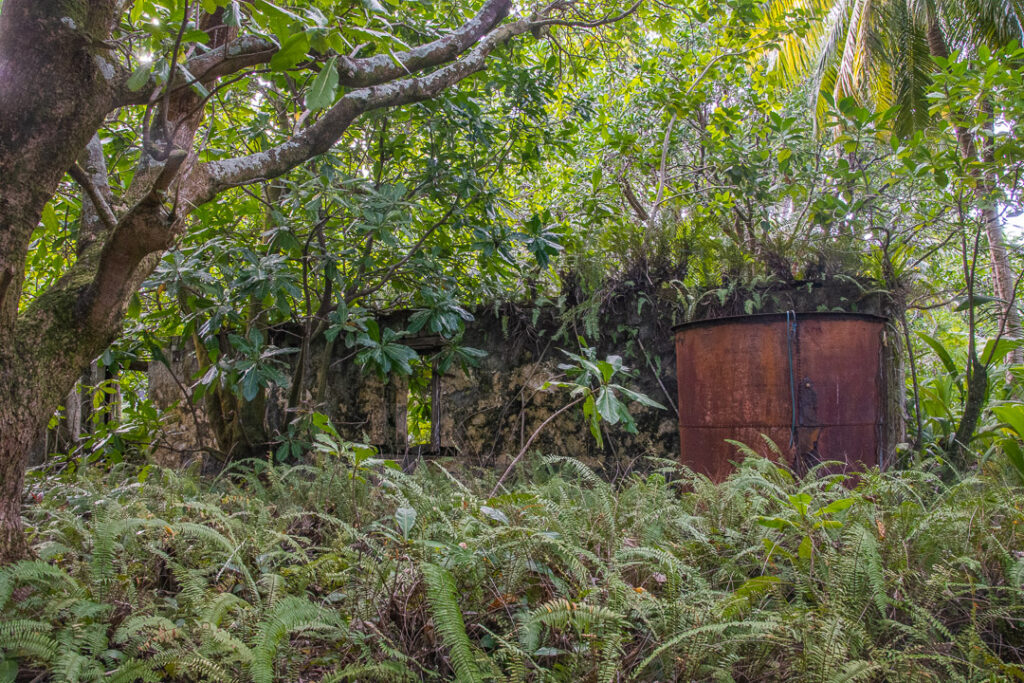
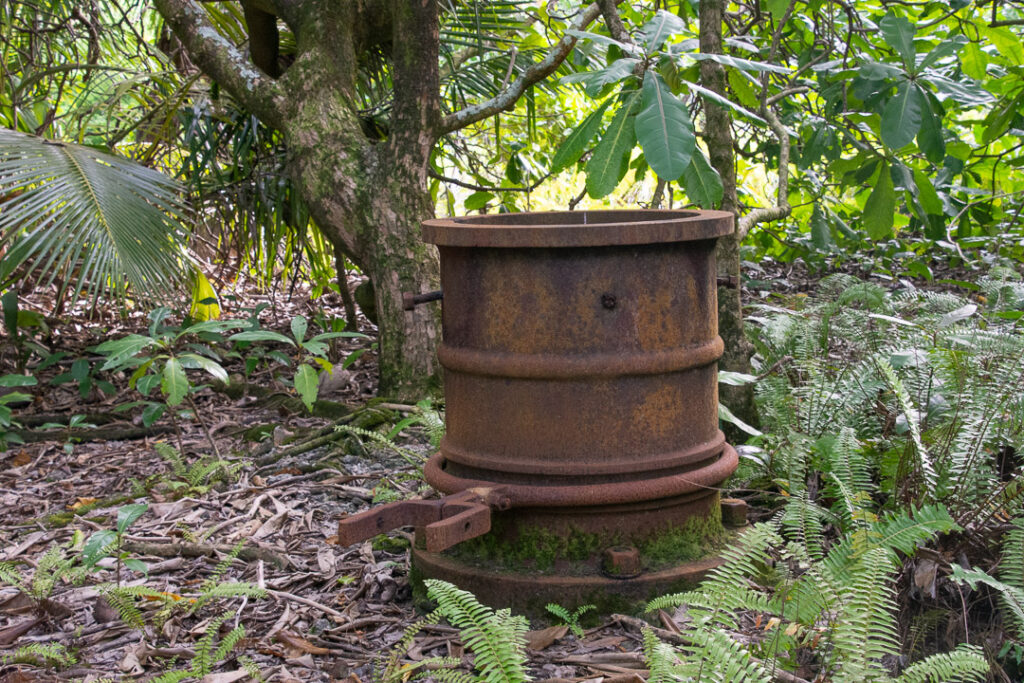
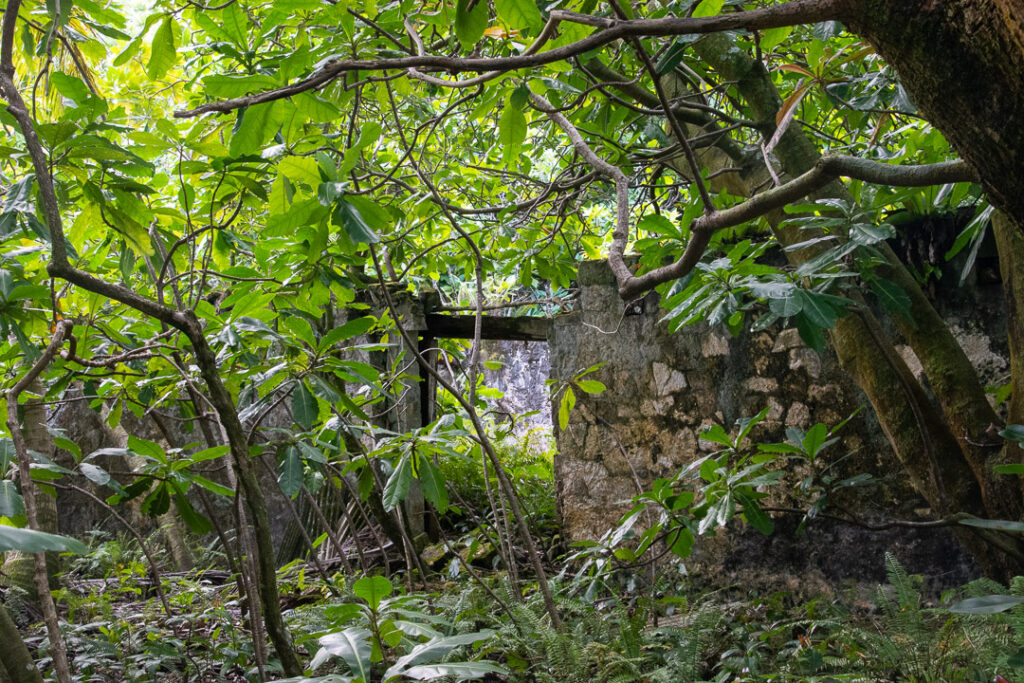
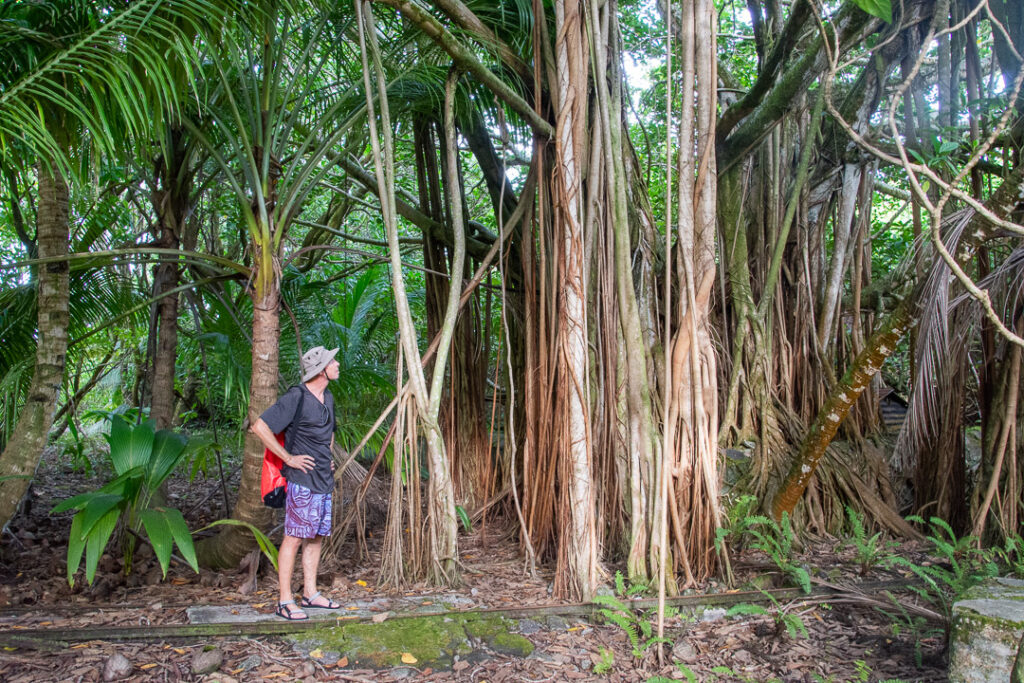
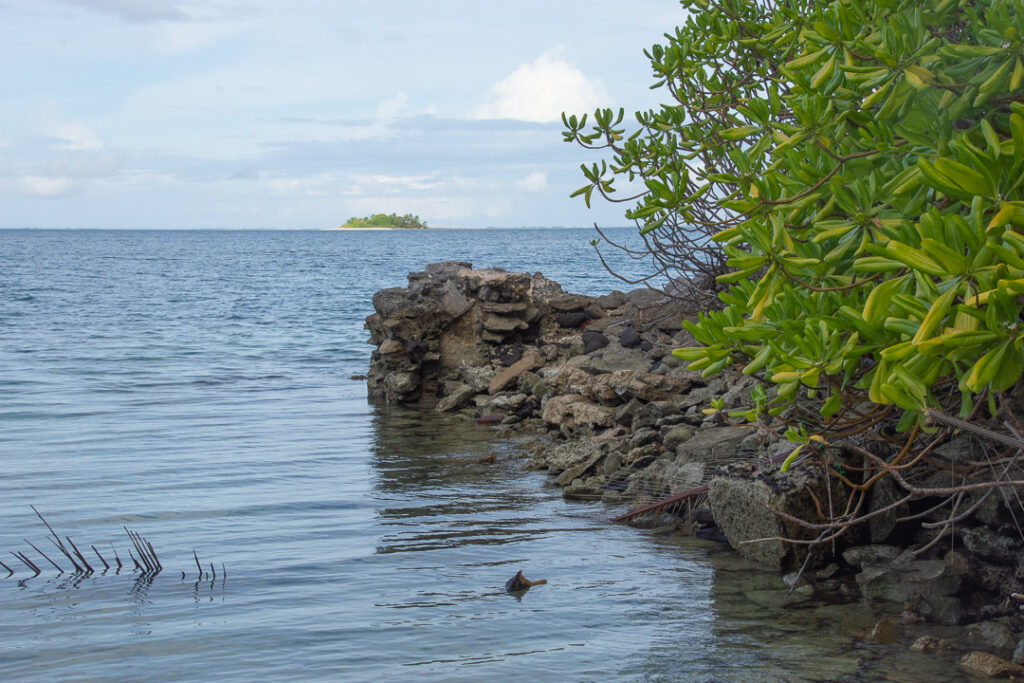
That night I woke at 4am and in the dark, moonless night Venus, Jupiter, Mars and Saturn were brightly visible, all in a line (Neptune was there too, but it would have required a telescope to see it). There were flashes of lightning in the distance and later, as I slept, it rained heavily with winds of 30 knots.
Below: on the left taken with my iPhone, on the right from Sky Guide app.
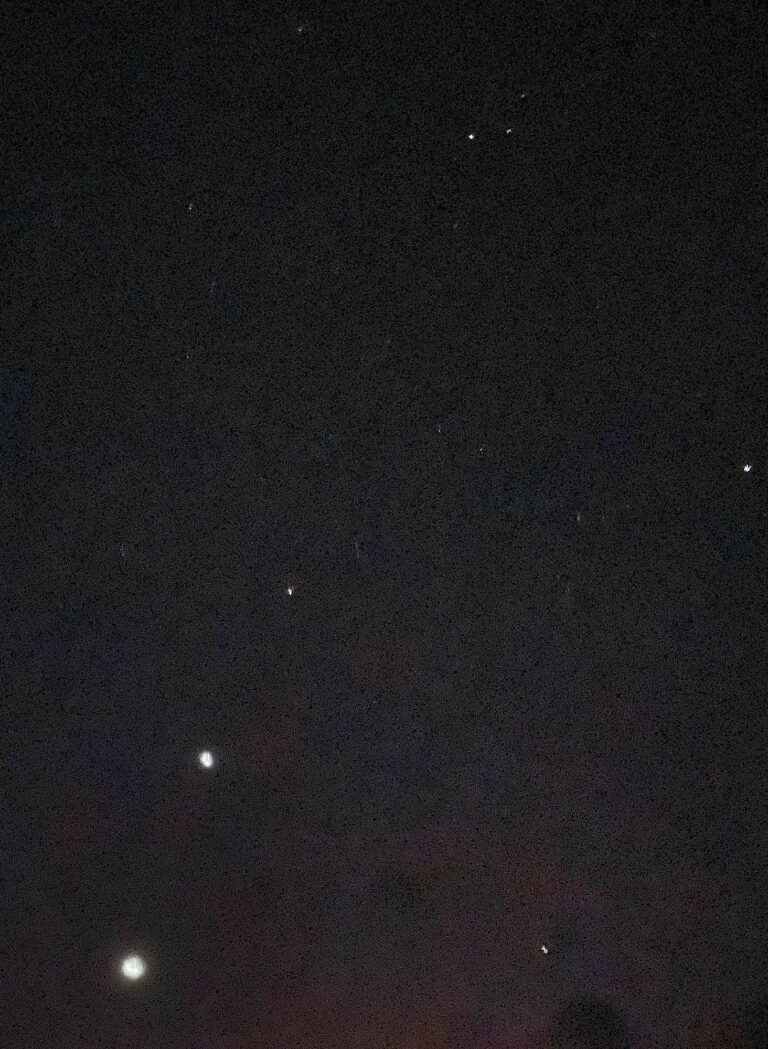
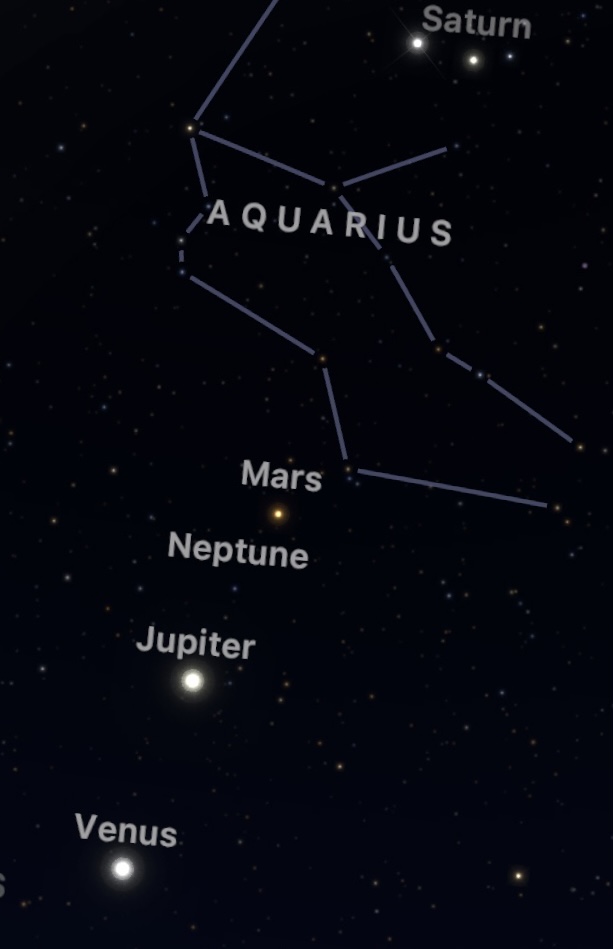
The next day, looking at weather forecasts, it was clear that we needed to get ready to leave Chagos on the following morning. The winds looked good then but after that they were forecast to die off and, as we wanted to avoid motoring, we needed the wind to sail. We spent the morning getting ready to leave and by the afternoon the weather had brightened enough to go ashore for one last time. Hugh was looking out and suddenly exclaimed ‘there are six men on the beach’!
We couldn’t think where they’d come from or how they’d got here. We emailed the BIOT Fisheries Protection officer who had no idea who they might be but advised us not to approach them. By now the men on the beach were waving a white flag and three of them started wading towards us so we headed over in the dinghy, taking food and water. It transpired that they were Indian fishermen whose fishing boat had gone aground the previous night on the fringing reef, out of our sight. There were another 8 of them still on their boat which was stuck on the reef, and they only had enough food and water for another day or two. They asked us to contact the Indian Police so they could be rescued and after some photos they headed back along the beach towards their boat. All hell then broke loose with the BIOT authorities who contacted London and New Delhi, emails were going to and fro, the situation complicated by the fact that the one Fisheries Protection patrol boat was ‘currently disabled’, under repair in the Maldives. An email to us, having warned us to stay away, now thanked us for our ‘intelligent initiative’ and requested that we act as go-between for them and the stranded fishermen!
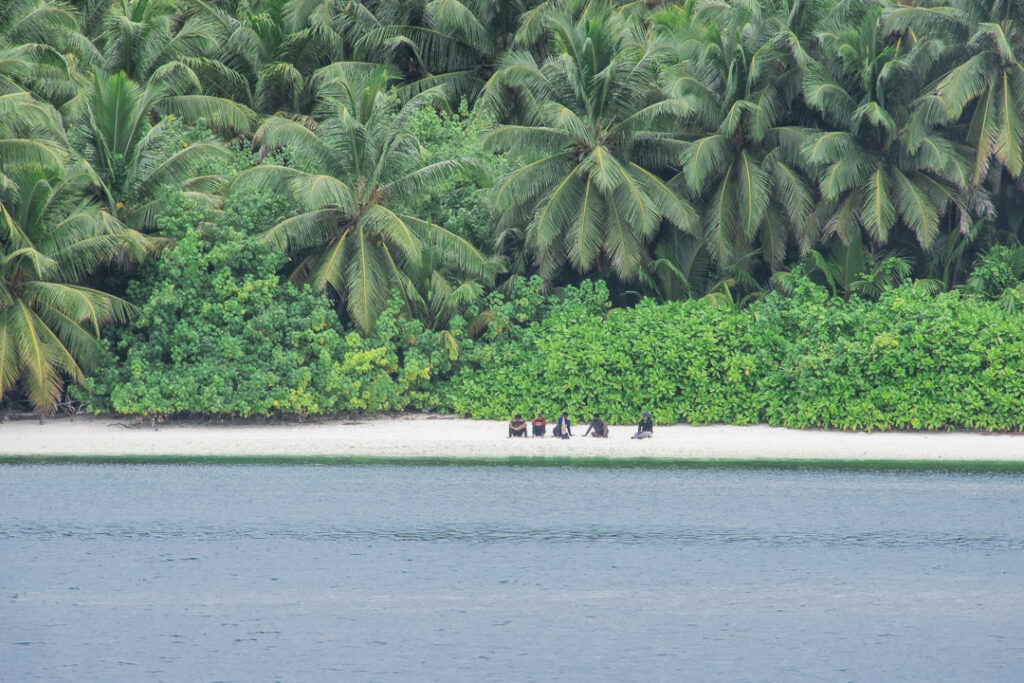
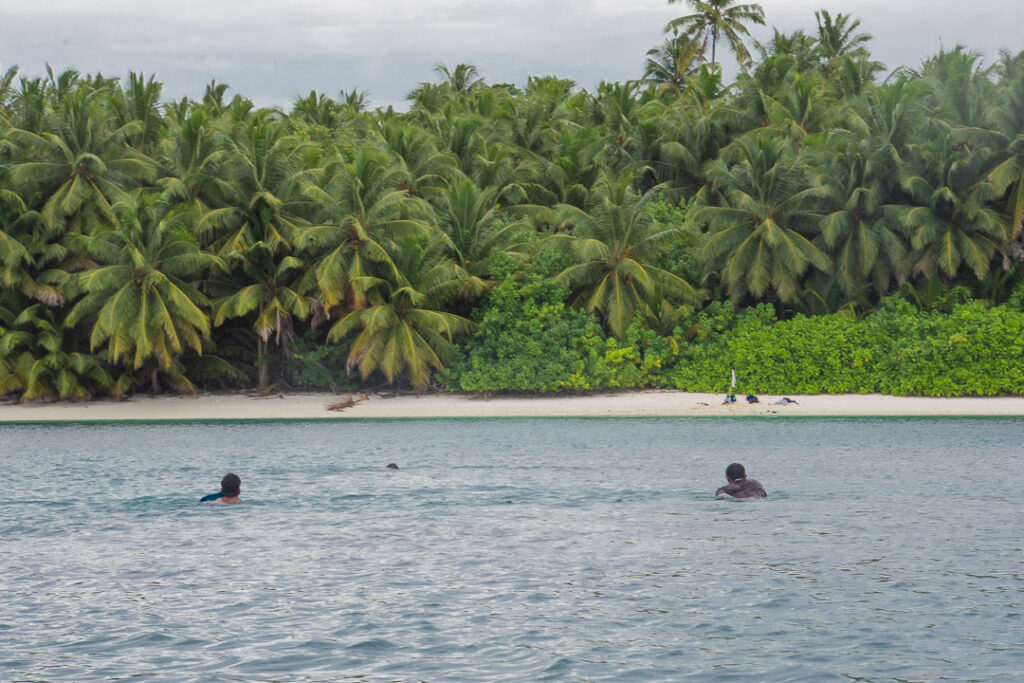
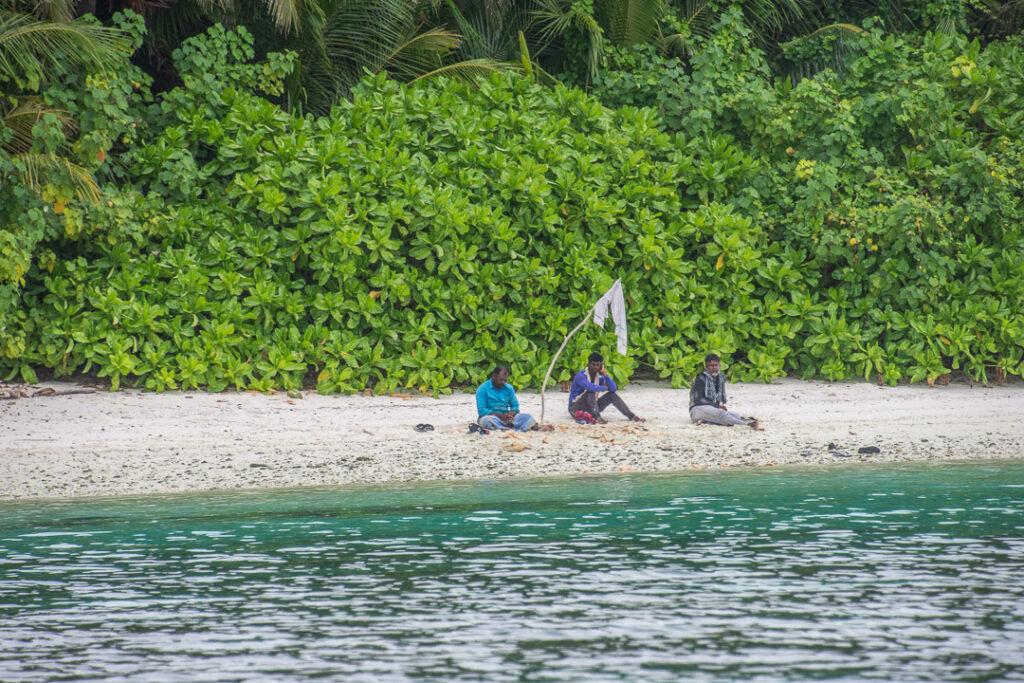
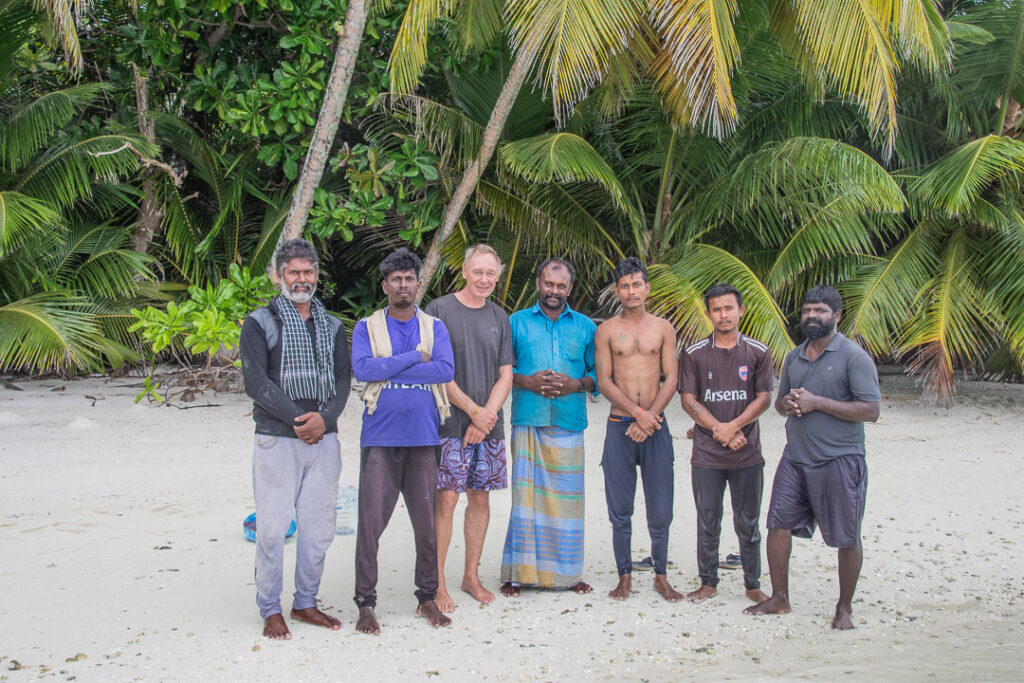
We just had time for snorkelling over some of the most stunning corals that we’ve seen so far in the Indian Ocean. Fabulous formations in turquoise and creamy white, with big parrot fish in greens and blues, and pretty reef fish of many varieties who weren’t a bit shy.
I was so sad to be leaving the next day, I’d have dearly loved to stay another week, but with the engine problem and a two day weather window and after that practically no wind, it had to be.
In the morning we were getting Vega ready for the passage on to the Seychelles when Hugh spotted three fishing boats just north of Ile Boddam, just outside the fringing reef. It looked like our fishermen were being rescued by their friends. We let BIOT know, who were mightily relieved as it solved their difficulty in organising a rescue. At the same time they recognised the irony of the situation… these fishing boats are all illegally in the BIOT waters!
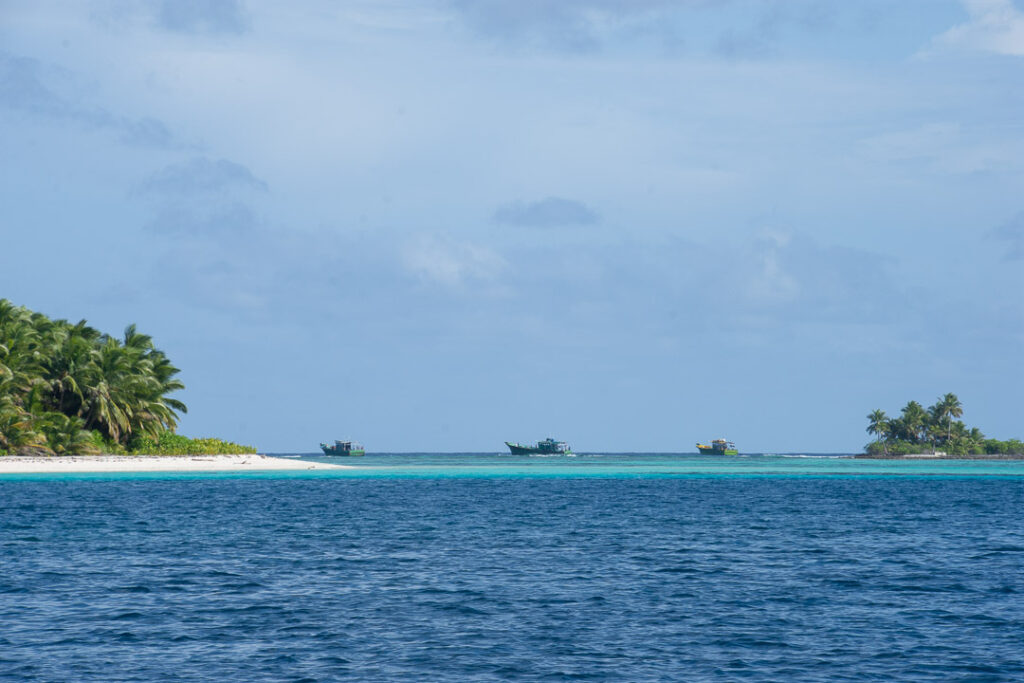
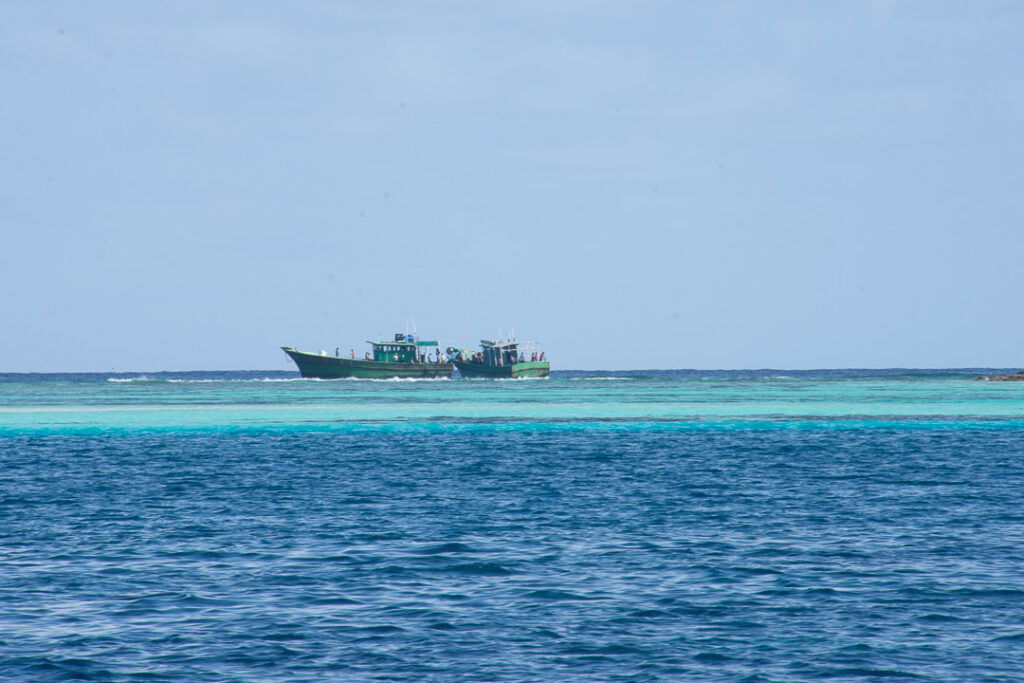
Cautiously making our way back across the lagoon to the pass and back out to sea, we raised the sails and then headed down the west side of the Salomon Islands where we could see four fishing boats sheltering by Ile Anglaise plus the stranded fishing boat still aground on the reef off Ile Boddam. There didn’t appear to be anyone left on board it.
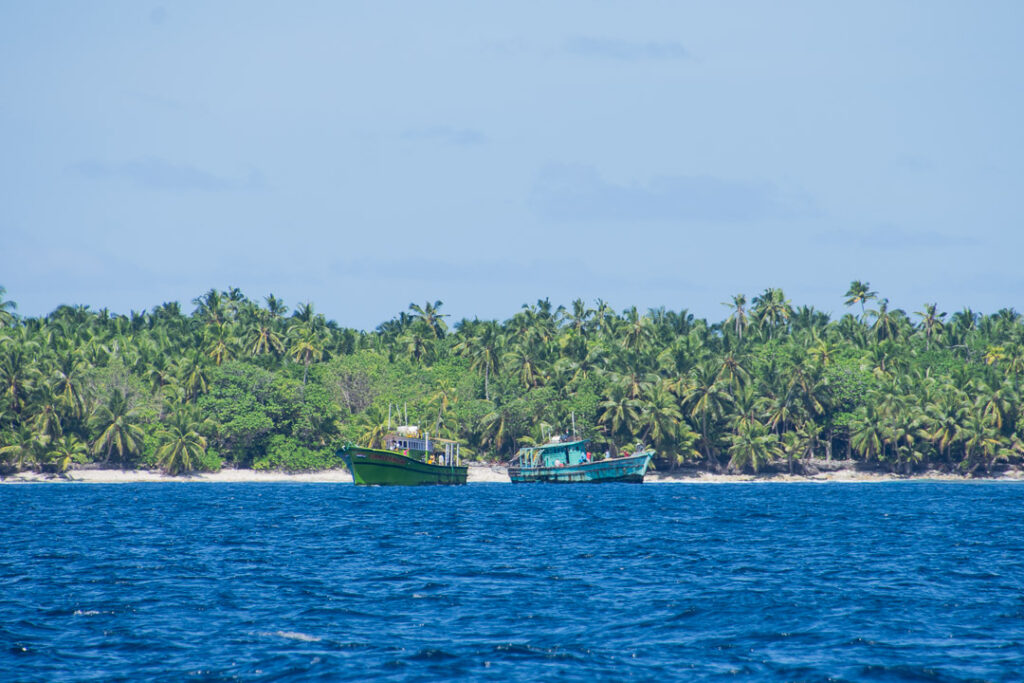
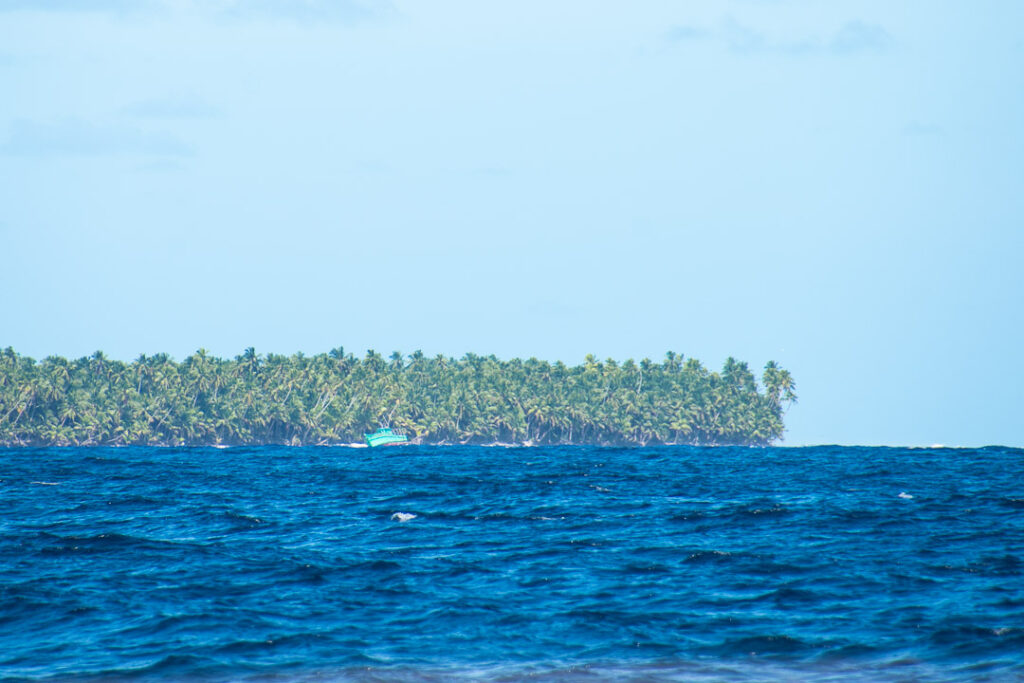
As we left the winds were a perfect 10 to 12 knots, the sea was reasonably smooth and we were making good speeds of 6+ knots. We were anticipating an eight day passage to the Seychelles but first we needed to head south to try to pick up the SE trade winds which should guarantee us an easy trip west. I was even rather looking forward to it. Little did I know……..
Postscript
In 2019 the International Court of Justice advised that the U.K. did not have sovereignty over the Chagos islands and that the administration of the archipelago should be handed back to Mauritius. The UN General Assembly voted to give Britain a six-month deadline to hand over the islands. So far there is no indication that Britain is prepared to comply.
The 2004 John Pilger documentary ‘Stealing a Nation’ is disturbing, shocking, just tragic. In a way I’m glad I didn’t see it before my visit to Chagos as I think it would have spoiled my pleasure during my time there. Please watch it if you want to understand just how disgracefully the Chagossians have been treated. If the link below doesn’t work you can find it on YouTube.

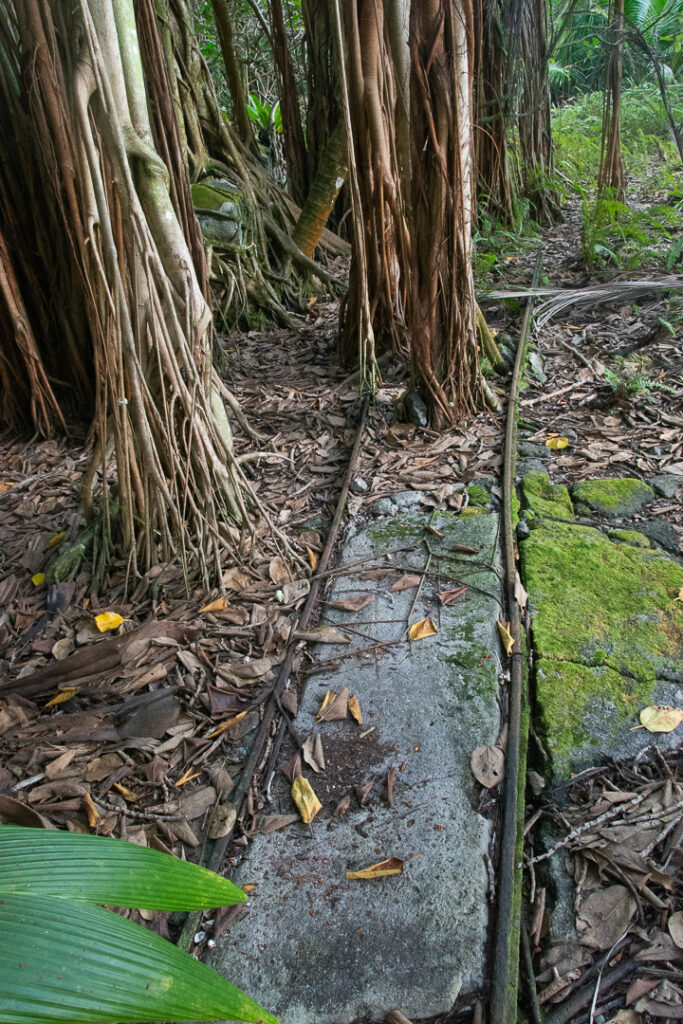
7 Comments
Gerard
July 17, 2022 - 8:37 pmAs usual wonderful photos mixed with a degree of anxiety
Hope all goes well.
Gerard
Annie Sparkes
July 18, 2022 - 10:16 amWow, that was an interesting read. And what if you hadn’t been there to relay the plight of the stranded fishermen! Buen viaje for your next leg. xxx Annie
Kathleen
July 18, 2022 - 10:23 amHey you two. Safe waters. Fantastic read. I had no idea what horrors we are. Hope to catch up with you and Stan . Kx
Paul Bayley
July 18, 2022 - 10:45 amCongratulations on your new arrival in the family. Great pictures and the wildlife is stunning. It is always a very interesting read and you get a real feeling of being there.
We are now in Kefalonia as retires starting out on our new adventure.
Steve
July 18, 2022 - 5:26 pmAnother stunning blog! xxx
Clare
July 18, 2022 - 11:06 pmSadly another example of how the British Government treats its Colonies and the indigenous peoples that live there. Mirrors how the indigenous peoples of Canada have been treated! Unfortunately real English History isn’t a hot topic in the education system!
Jocelyn Dawson-Wood
July 22, 2022 - 7:14 amHi Annie, a great read! What an adventure you’re having. I’ll look forward to the next installment. Jos x